Nate Silver's Blog, page 147
October 27, 2015
The 53 Best Franchise Players In The NBA
NBA player rankings, from ESPN’s #NBARank to Bill Simmons’s annual trade value column, are like the honey butter chips of sportswriting: just way too hard to resist. So — with the regular season starting today — here’s our special recipe, fueled by CARMELO, our new NBA player projection system.
What makes our version a little different is that we’re focused on the long term and not just this season. Specifically, we’ve projected the next six seasons of wins above replacement (WAR) for all 572 players in our database. Then we added the cumulative WAR totals over six seasons, with a slight tweak to reflect upside potential.1 You can check out all the rankings in the sortable table (way, way down) below, but we also wanted to count down the top 50 players — well, make that the top 53 players2 — first.
Two things we can’t stress enough: First, these ratings are purely statistical; there’s no manual tweaking involved. And second, focusing on the long term makes a lot of difference. Tim Duncan doesn’t appear in the top 53, but Jusuf Nurkic does.
A few more notes: Player ages are as of Feb. 1, 2016. And because we’re trying to forecast what the NBA will look like a few years out, these WAR projections do not account for injuries or minutes limitations — with the exceptions of Michael Kidd-Gilchrist and Joel Embiid, who are out for the season and whose WAR figures we’ve zeroed for this year. These upside WAR totals will not necessarily match the raw six-year WAR totals in the player cards.
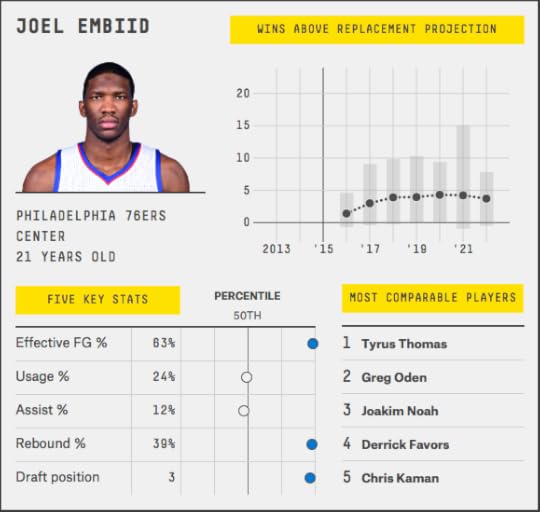
53. Joel Embiid (Upside WAR projection through 2020-21: 19.9)
Embiid sneaks onto our list at No. 53. (Where would he rank if he hadn’t been hurt for the past two seasons? A lot higher — probably about where Karl-Anthony Towns does at No. 26.) CARMELO still harbors dreams about how Embiid’s shot-blocking could make him the next Joakim Noah. But given Embiid’s injury history, the Greg Oden comp looks increasingly scary.
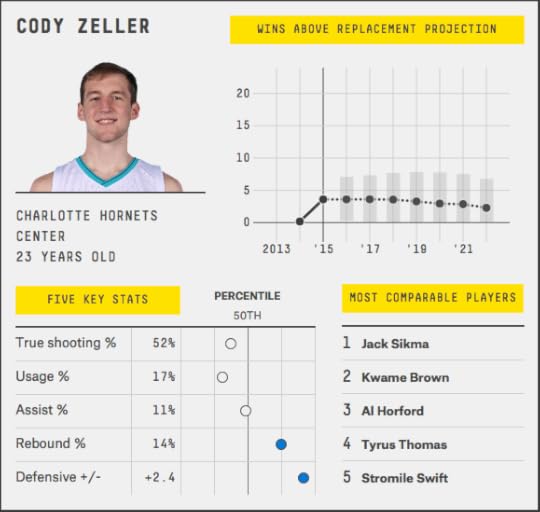
52. Cody Zeller (20.0)
CARMELO’s best guess is that Zeller will produce like a solid starter over the next handful of seasons. But remember, that’s just the mean forecast. The variance is wide because Zeller’s closest historical comparables are all over the place. Maybe he’ll develop into a star, like No. 1 comp Jack Sikma,3 Al Horford (No. 3) or Rasheed Wallace (No. 9). Then again, maybe not — Zeller’s comp list is also littered with names like Kwame Brown, Tyrus Thomas and Stromile Swift.
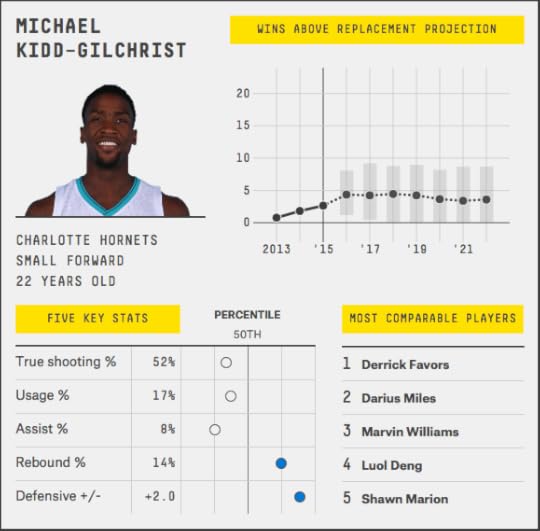
51. Michael Kidd-Gilchrist (20.1)
Kidd-Gilchrist, like Embiid, will miss the 2015-16 season. The injury could preclude the Hornets from what might otherwise have been a breakout season. It will also preclude Kidd-Gilchrist from gaining a year of experience he needs to round out his offensive game. So far, he has neither been adept at creating good looks for himself nor shooting the ball well when he has. Nonetheless, Kidd-Gilchrist has precocious defensive abilities and will be just 23 when he returns to competition next season. Health willing, he could develop into a Matrix-like player.

50. Victor Oladipo (20.3)
Although CARMELO loves the other young Magic point guard (Elfrid Payton) even more, Oladipo’s projection isn’t too shabby. But of course, there’s still some uncertainty about what Oladipo can become: “His first two seasons have been so hard to get a bead on that you can peg him for just about any future you want,” we wrote. Whether Oladipo turns into Ray Allen or Ben Gordon will depend largely on whether he can develop a more consistent shooting stroke.
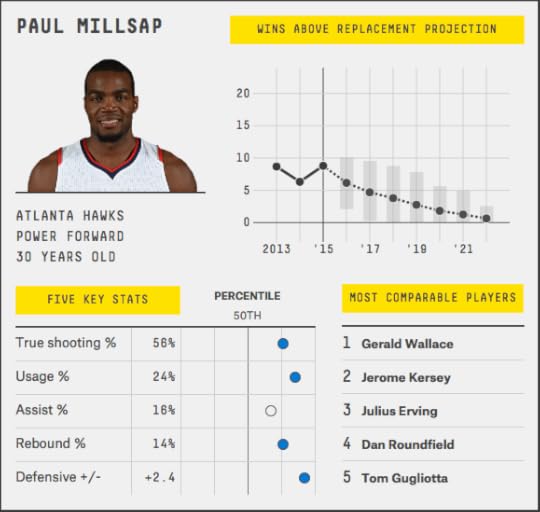
49. Paul Millsap (20.6)
Last year Millsap had a banner season, making his second All-Star team. It came because of all-around excellence: Millsap is a solid defender, like top comp Gerald Wallace, and well-rounded on offense (even if the Julius Erving parallel is a bit much). But as we’ve pointed out, Millsap is projected to regress a lot this season; more often than not, a career-best season at age 29 proves to be a career year.
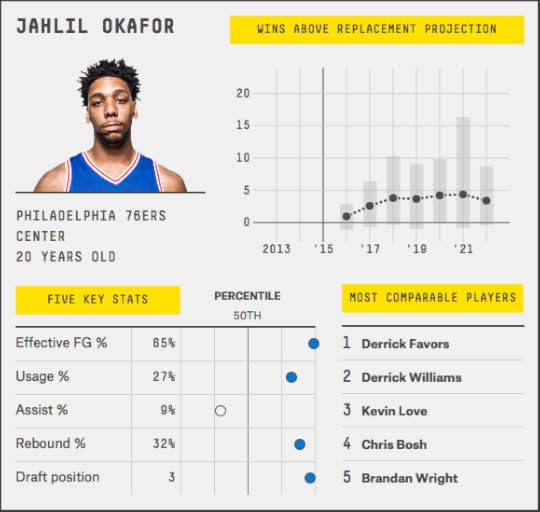
48. Jahlil Okafor (20.7)
Okafor is a great prospect, though possibly also a guy who will look better in the box score than on the court. His lack of elite athleticism and sketchy defensive potential could make him something like Kevin Love without the outside shooting (hence the comp to bust Derrick Williams). But he’s also a great rebounder with nifty post moves, a classic combination for any aspiring big man. And if he does develop like top comp Derrick Favors on defense, the sky could be the limit.
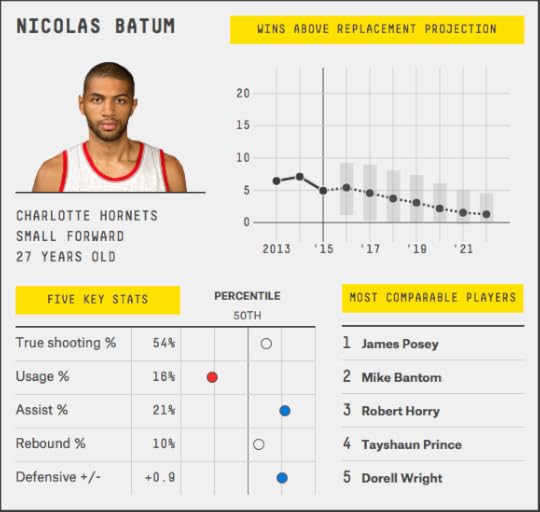
47. Nicolas Batum (20.7)
Batum’s shooting regressed last season in Portland, but the newly signed Hornet still provides stellar perimeter defense. Hence the two types of comps: shooters such as Robert Horry and Dorell Wright, and defenders such as Tayshaun Prince. Players who combine both of those elements — i.e., the 3-and-D player — are all the rage in today’s NBA, but unlike many of his peers in that category, Batum also adds a playmaking dimension to his team’s offense.

46. Andrew Wiggins (20.8)
Wiggins’s top CARMELO comp is … well, Carmelo (Anthony). As we wrote, the NBA’s reigning Rookie of the Year could be “very good, but between mediocre defense and average efficiency, not quite as good as his box-score stats suggest.” Wiggins’s upside and versatility are apparent in his comp list, though — witness the presence of Derrick Rose (No. 5) and Chris Bosh (No. 8), two stylistically different players who were bona fide superstars at their peaks.
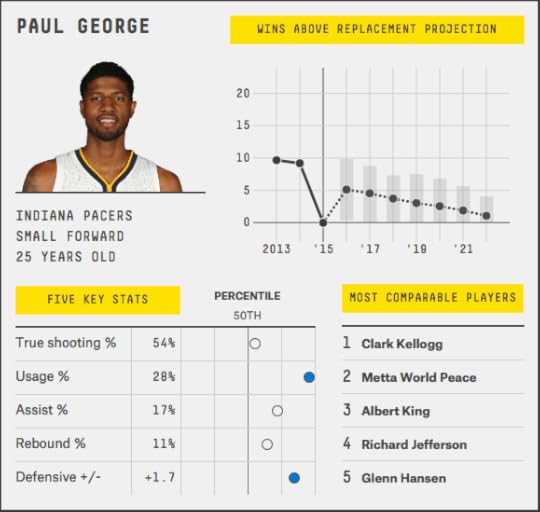
45. Paul George (21.0)
George’s future was in jeopardy after he suffered a catastrophic leg injury in the summer of 2014. So his playing at all last season (he came off the bench in six games late in the year) was a moral victory. There’s some further good news: Seriously injured NBA players like George have a better track record of recovery than their counterparts in other sports. Nonetheless, the Clark Kellogg comp is scary; a fellow Pacer, he started his career with great promise, only to be rendered a shell of his former self after a series of knee injuries.
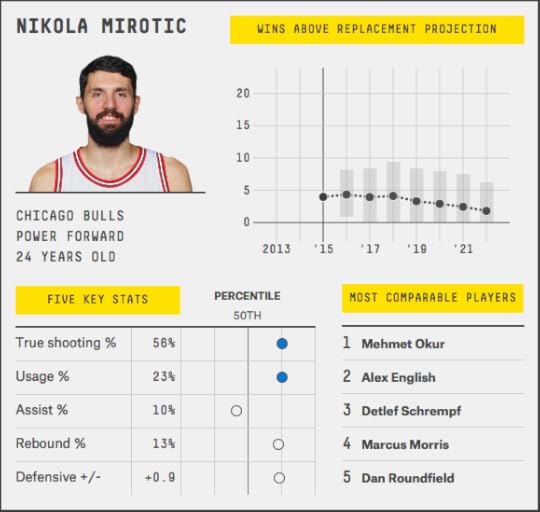
44. Nikola Mirotic (21.2)
Mirotic finished second in Rookie of the Year voting, behind Wiggins, and is now a huge building block for the Bulls. The Detlef Schrempf comp is just too perfect: a tall, international forward with an excellent 3-point shot. Now all that’s left is for Mirotic to guest star on the 2040 equivalent of “Parks and Recreation.”

43. Jared Sullinger (21.2)
With a bevy of crafty post moves, the undersized Sullinger has made an old-school playing style work for him. Although he sometimes struggles to score around the basket, the development of his outside shot keeps the Celtics happy and is one of several reasons CARMELO expects the Celts to have a breakout season. The throwback comp to Lonnie Shelton is dead on, though Sullinger has to do some work to move past where Shelton was at the same age.
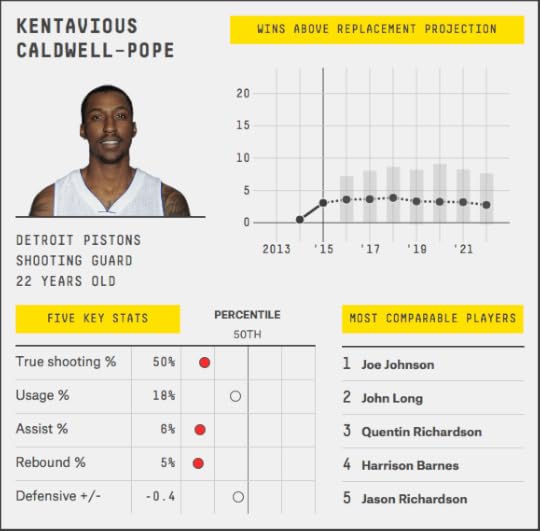
42. Kentavious Caldwell-Pope (21.2)
Caldwell-Pope is young and athletic and has a silky-smooth jumper. The problem is that these skills offset weaknesses elsewhere: His shot selection, playmaking and rebounding all need work. As we wrote in our Pistons preview: A “second coming of Ray Allen (Caldwell-Pope’s sixth-closest comp) would be a bonanza, but don’t bank on it.” Still, players as young as Caldwell-Pope have lots of opportunities to defy the odds.
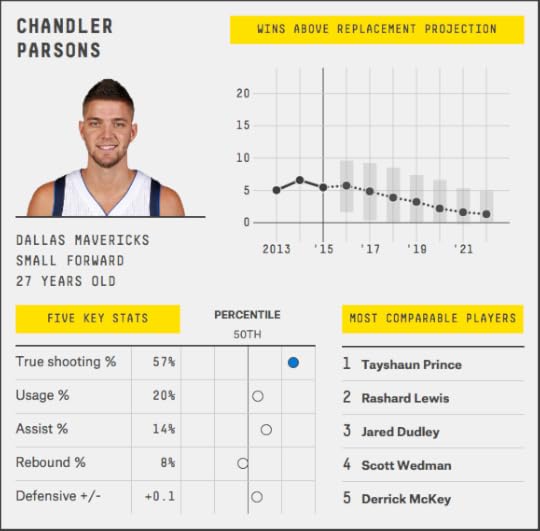
41. Chandler Parsons (21.8)
Parsons is a lanky wing defender with an efficient outside shot. He’s a blend of Tayshaun Prince on defense and Rashard Lewis on offense — and his skill set could become even more diverse if, as Tim MacMahon writes, the Mavs have him play more point-forward. The question is whether, at age 27 this season, Parsons can develop a signature skill that transforms him from a well-rounded, above-average player into a star.
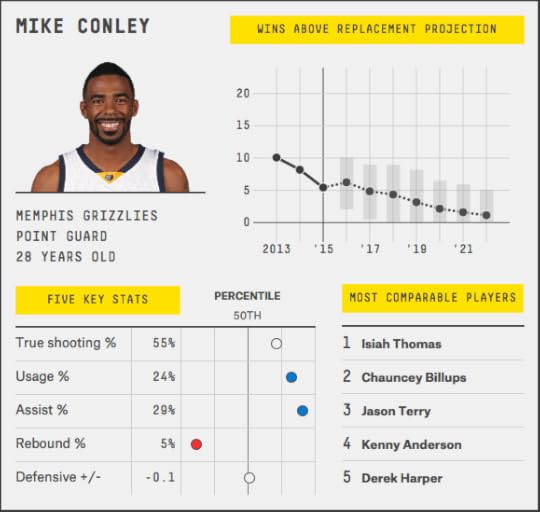
40. Mike Conley (22.5)
The Isiah Thomas comp provides a vision of Conley at his best: a gritty, undersized point guard with a great passing instinct and solid jumper. But as Carl Bialik notes, “his defense has dropped off in recent years,” so there is reason to worry he’ll be a worse-shooting Jason Terry in his later career.
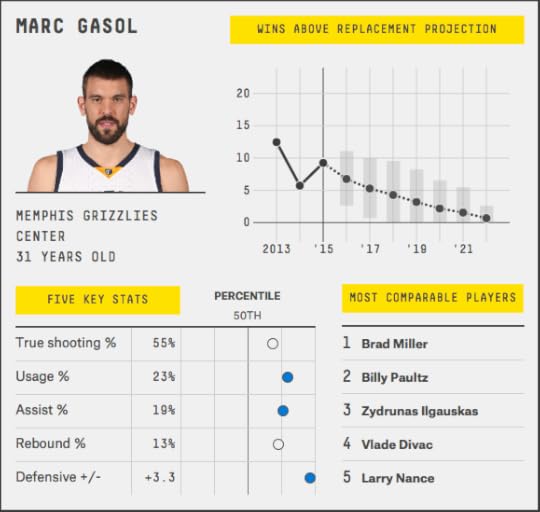
39. Marc Gasol (23.3)
The big Spaniard (and Conley’s fellow Grizzly) was once again one of the league’s best centers last year, and he’s definitely inherited comp Vlade Divac’s gene for great post passing. But at 31 years old, Gasol has only so many years left. Big men tend not to age as well as wings and point guards, and the Grizz should worry about a decline to Brad Miller levels of production.
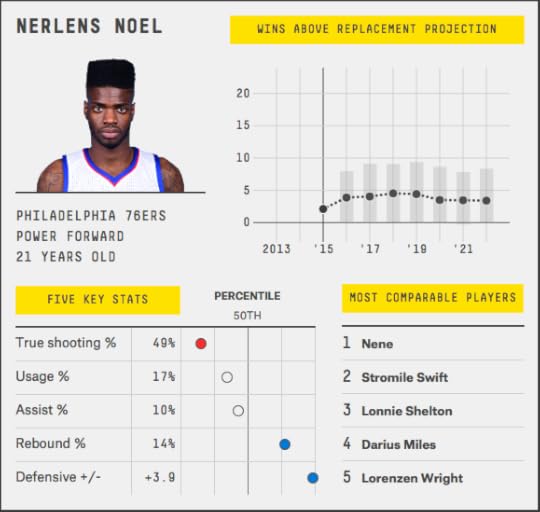
38. Nerlens Noel (23.9)
Noel’s defense was a bright spot among the garbage heap that was the Sixers. As Ian Levy wrote, Noel ranked “among the top 5 percent of all players in steal rate, block rate and overall defensive plus-minus.” That’s awfully impressive for a guy who was just 20 years old. But with no discernable offensive skills — his 49 percent true shooting percentage was abominable for a guy who spends so much time around the rim — he gets stuck with a Stromile Swift comp along with more optimistic options like Nene.

37. Kyle Lowry (24.0)
Lowry is a stout and tough point guard, so his comps to Rod Strickland and John Starks are spot on — and both players aged relatively gracefully. But if he can expect a gentle decline, a breakout season is probably not in the cards. “Many of the guards CARMELO sees as most similar to Lowry had already peaked by his age,” Carl Bialik noticed. In other words, at 29 years old, Lowry’s probably not getting any better.
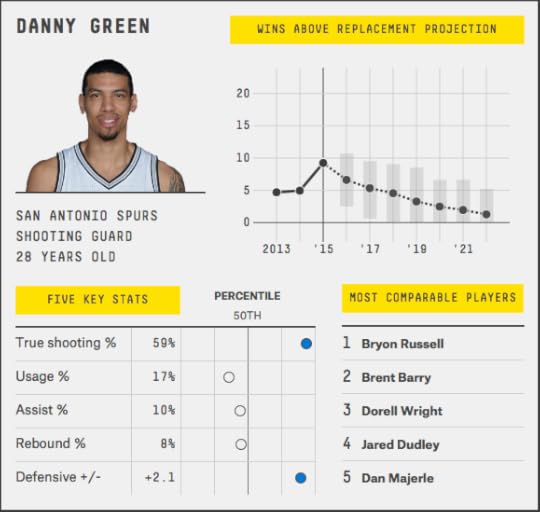
36. Danny Green (24.3)
Green already has overshot low expectations since he was chosen with the 46th pick in 2009. Green is a 3-point threat — comps to Brent Barry and Dan Majerle show that. But he’s also a great wing defender, like Bryon Russell. The only catch is that players who overachieve as much as Green don’t necessarily have much room to get better as they enter their late 20s. CARMELO gives Green only about a 15 percent chance of bettering his career-high 9.2 WAR from last season.
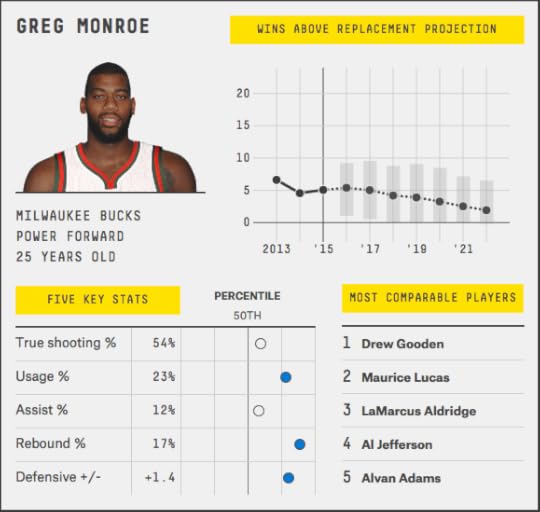
35. Greg Monroe (24.4)
Monroe, the newly signed Buck, is “an offensive-minded center who can average a double-double [and] score inside and from the perimeter,” as Ohm Youngmisuk wrote. His skilled footwork in the post makes the Al Jefferson comp perfect. Still, Monroe didn’t improve his productivity between his age-22 season in 2012-13 to his age-24 season last year. He could be a WYSIWYG player: someone whose current skill set provides plenty of value to an NBA lineup, but who isn’t a great bet to develop further.
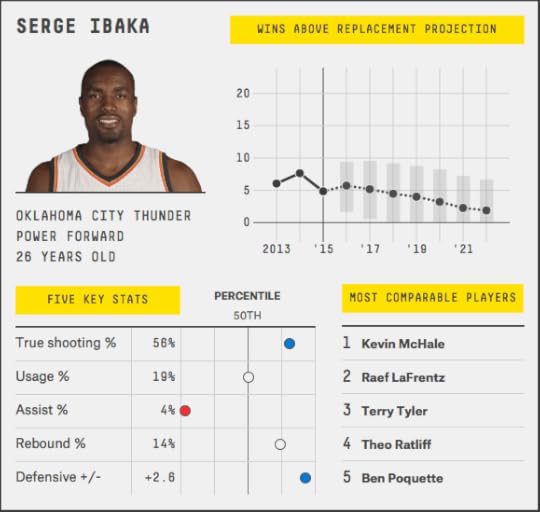
34. Serge Ibaka (25.0)
As Royce Young observed: “Ibaka isn’t quite ‘big’ enough to help form a Thunder big three, but he’s without question integral to the team’s success.” But is there any chance Ibaka could develop into more than that: an All-Star talent alongside Kevin Durant and Russell Westbrook? Just maybe. Kevin McHale, Ibaka’s No. 1 comp, is a favorable precedent: He had his best seasons in his late 20s and early 30s as he developed more of an outside shooting stroke. Ibaka, likewise, has improved his outside shooting almost every season and shot .376 from 3-point range last year.

33. Jrue Holiday (25.0)
Holiday has loads of talent and even made an All-Star team a few years back, but injuries have plagued his development. They’ve also concealed improvement in Holiday’s efficiency, however. When he played last season, Holiday shot the ball better and turned it over less often than during his All-Star campaign in 2012-13. The Pelicans will limit Holiday’s playing time at the start of the season, perhaps recognizing that all that may stand between Holiday and a breakout is being healthy enough to play in 82 games.
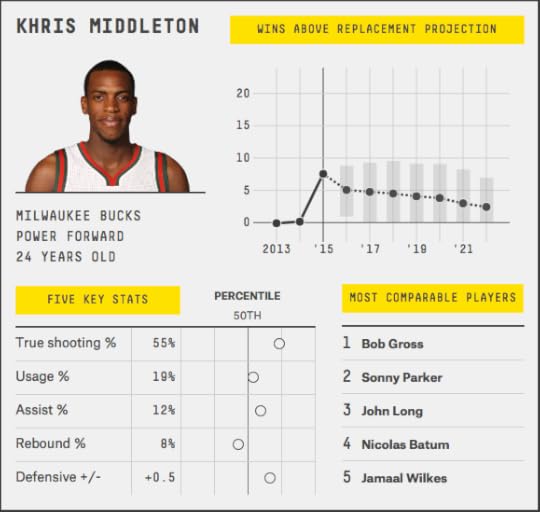
32. Khris Middleton (25.3)
Middleton is a Swiss army knife. As Ohm Youngmisuk writes, Middleton’s comps indicate that his game is old-school: “Middleton may not be flashy, but he plays hard, and his throwback game is a nice complement to his flashier and younger teammates.” He has one decidedly new-school skill, however: Middleton is a career .403 shooter from 3-point range. There’s a universe where Middleton develops into Peja Stojakovic (his No. 10 comparable) but with much better defense.

31. Klay Thompson (26.2)
Thompson’s No. 31 slot on CARMELO’s list might seem disappointing; by contrast, he slots in at No. 16 in #NBARank. His scoring is superlative, of course; Thompson is not only one of the best shooters in the game but also has the size and quickness to get to the rim. However, his defense and rebounding are below average. You can be an All-Star on the basis of scoring alone, but probably not a superstar.
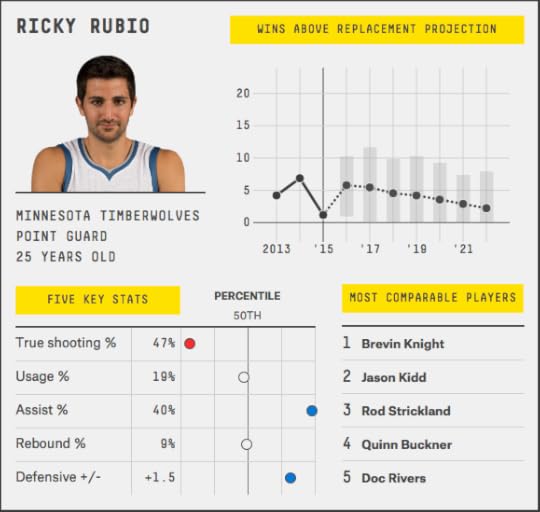
30. Ricky Rubio (26.5)
Can Rubio, an exceptionally gifted passer and ball thief, ever develop a jump shot like comparable Jason Kidd did in his later years? CARMELO, seeing how Rubio is just 25, is optimistic, projecting him to improve his offensive efficiency to career-high levels. But if not, the shadow of his Brevin Knight comp looms over him.

29. Derrick Favors (26.6)
Why are we optimistic about the Utah Jazz? Because Favors ranks among the top 30 long-term NBA players — and yet, he ranks only third on the list among members of the Jazz frontcourt. Coming off his best year yet, Favors is, as Ian Levy writes, “already one of the better defensive bigs in the game,” with an improving offensive skill set. The Jazz hope he blossoms into the next Reignman.
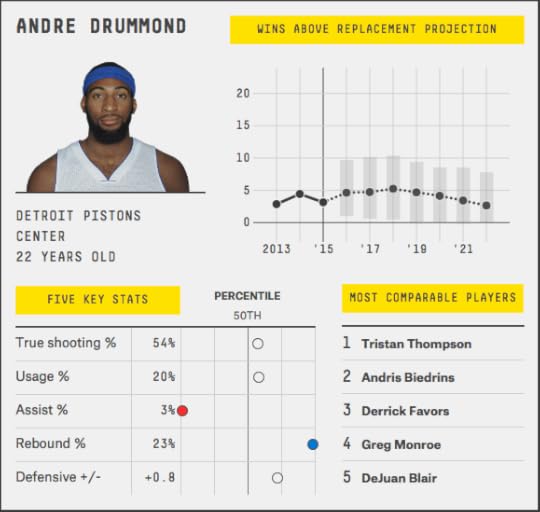
28. Andre Drummond (26.7)
Drummond is a “100th-percentile rebounder and elite rim protector,” as we wrote in our Pistons preview. That’s nice, but it can also be a recipe for being too one-dimensional, and Drummond’s dreadful free-throw shooting limits his value on the offensive end. At age 22, he has reasonable odds of making a leap forward at some point, but he’s an oddball player with comps ranging from Andris Biedrins to Moses Malone.
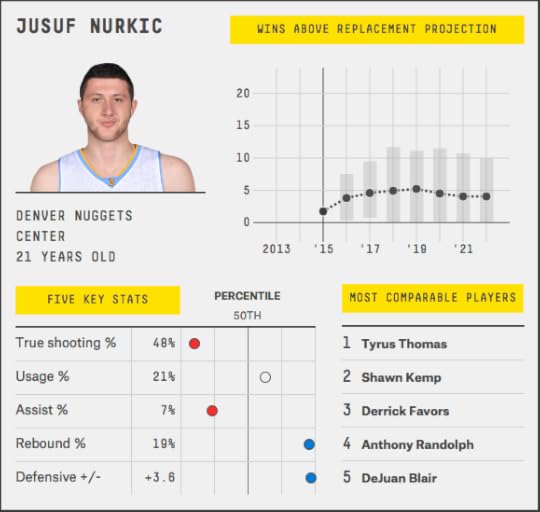
27. Jusuf Nurkic (27.2)
The big Bosnian defies every outmoded stereotype of “soft” European players. Instead he has a mean streak as a bruising defender and talented young rebounder. Aside from Shawn Kemp, the top comps may not wow you, but if Nurkic’s shooting efficiency improves, the Nuggets have landed their franchise center.

26. Karl-Anthony Towns (27.4)
As we pointed out in our Timberwolves preview, Karl-Anthony Towns has some discouraging comps. If the No. 1 pick in last year’s draft flames out like Anthony Bennett or Greg Oden, that’s a disaster for Minnesota. But CARMELO projections are based on dozens or hundreds of comparables for each player and not just two — and there are plenty of more optimistic names (such as Anthony Davis and DeMarcus Cousins) farther down Towns’s list.
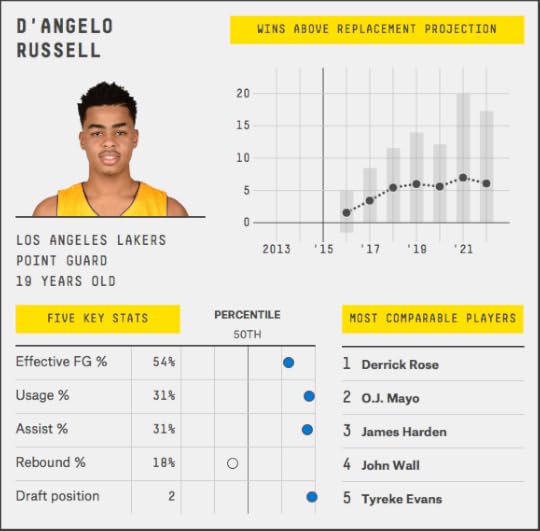
25. D’Angelo Russell (29.6)
CARMELO would have taken D’Angelo Russell ahead of Towns for the No. 1 pick, however. With good size and strength to round out a nice shot and excellent passing, Russell draws comparisons to other scoring point guards/combo guards such as Derrick Rose and James Harden. Don’t expect much efficiency this year: As Baxter Holmes wrote, the rookie “will probably pile up some head-shaking turnovers” for a Lakers team with miserable discipline. But Russell has superstar upside.
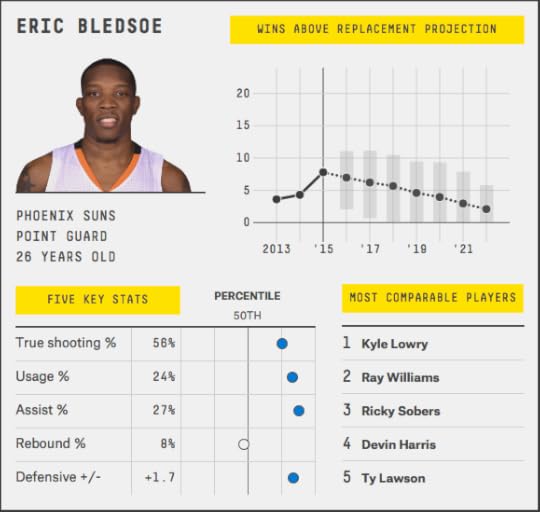
24. Eric Bledsoe (30.4)
Bledsoe is a long way from being “mini LeBron,” but he has a lot going for him: strength like Kyle Lowry’s alongside the speed of Ty Lawson. What he lacks is a consistent outside shot: His .324 3-point percentage last year ranked just 69th out of 76 players who took at least 250 3-point shots. He turns 26 this season and has passed the point where he can necessarily expect rapid improvement; he might be better off mothballing his 3-pointer and concentrating on the rest of his otherwise well-rounded game.
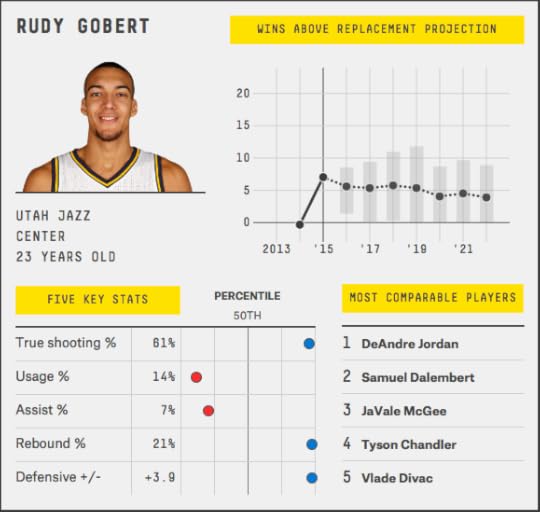
23. Rudy Gobert (30.7)
The second member of the Jazz frontcourt to make the top 30, Gobert went from an afterthought in his rookie season to a guy who leads his draft class in WAR. Ian Levy summed up the Stifle Tower nicely: “an elite rebounder and shot-blocker and an efficient finisher around the rim.” He also lacks much in the way of a jump shot, having shot under 22 percent last season on shots more than 3 feet from the basket. But if Gobert proves to be the next DeAndre Jordan or Tyson Chandler, Jazz fans won’t have much basis to complain.

22. Gordon Hayward (31.2)
The third jewel in the Jazz’s frontcourt crown, Hayward has come an awfully long way for a guy who — we mean this as a compliment — once came across as a bit of a nerd. The question is not whether he’s a legit NBA player (Hayward was already playing at a borderline All-Star level last season), but which path his future might take. His comparables include a mix of versatile, jack-of-all-trades players such as Andre Iguodala and hard-edged scorers such as Chris Mullin. The Mullin comp is particularly interesting given that Mullin (like Hayward) struggled with 3-point shooting consistency early in his career.
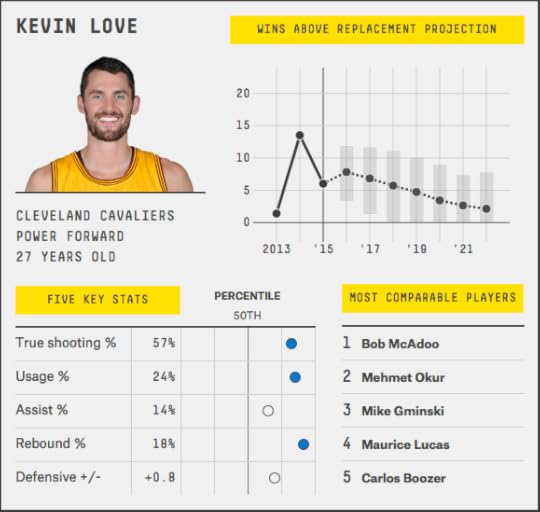
21. Kevin Love (31.3)
If everyone was a bit too optimistic about what the addition of Love might mean for the Cavs last season, he may be underrated now. Sure, Love had trouble integrating into Cleveland’s system last year and experienced a major decline in the number of shots he generated near the rim, which also had some knock-off effects on his other statistics (for instance, he drew fewer fouls and grabbed fewer offensive rebounds). But as was the case for Dwyane Wade and Chris Bosh, he may be better in his second year playing with LeBron, and he still projects to be a valuable rebounding hawk/stretch power forward.
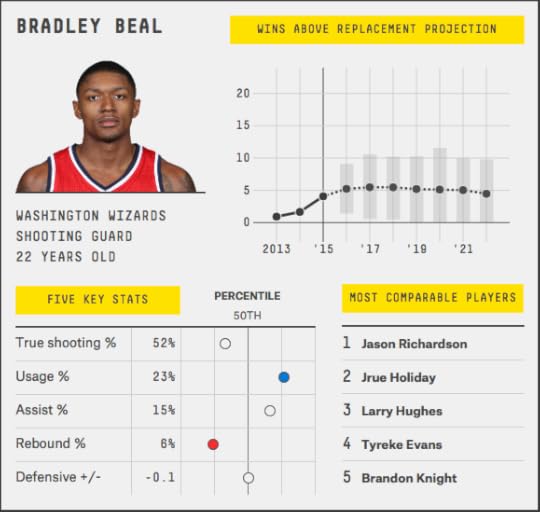
20. Bradley Beal (31.5)
Beal, the Wiz’s 22-year-old shooting guard, doesn’t have any stunning comps among his top five. But look down to No. 10 and you’ll find … Kobe Bryant. Guys who log so much playing time at such a young age can sometimes see radical improvements in their shooting efficiency, and if that happens, Beal will be an All-Star-caliber player.

19. Giannis Antetokounmpo (34.2)
The sky’s the limit for the Greek Freak. Antetokounmpo has an unusually well-rounded skill set for someone who’s about to turn 21 years old, including certain skills (he’s already a good defender and excellent at drawing fouls) that are usually associated with more mature players. He’s still working out what sort of player he wants to be on the offensive end — he dramatically cut down on his 3-point shot last year (but, oddly enough, took a lot of long twos). All of this leads to an eclectic set of comparables that includes superstars like Kevin Garnett and Tracy McGrady — along with busts like Darius Miles and Marvin Williams.
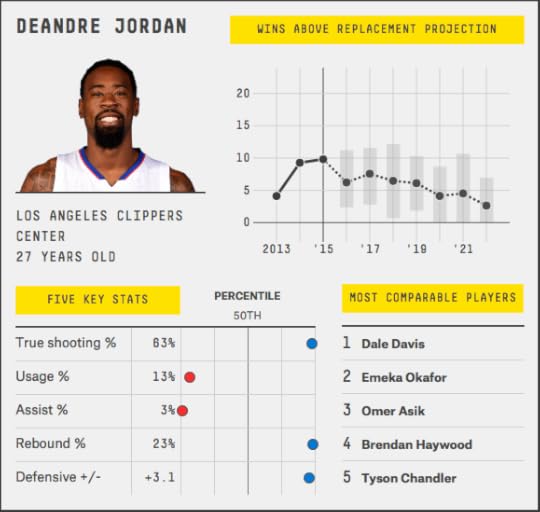
18. DeAndre Jordan (35.1)
You know what you’re getting here. Jordan’s skills are either elite (rebounding, shot-blocking) or cringe-worthy (shooting, passing). But as we wrote in our Clippers preview, “dunk-and-defense” guys like Jordan, Dale Davis and Tyson Chandler can be cogs in championship-caliber teams.
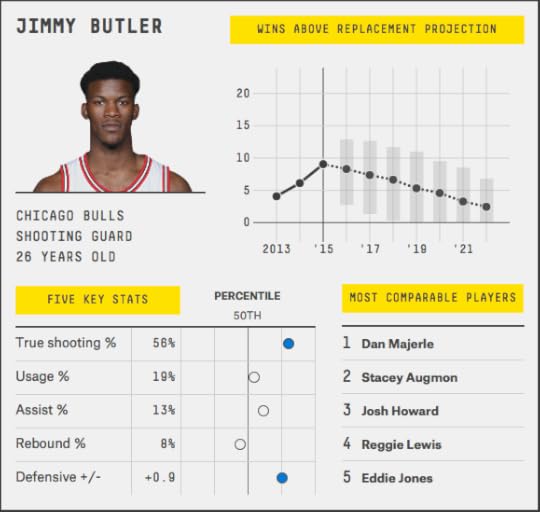
17. Jimmy Butler (35.4)
Bulls fans won’t be happy with the omission of Derrick Rose from our list (Rose ranks just 165th after three injury-filled seasons). But that’s OK: The Bulls have a new star in Jimmy Butler, an athletic wing defender with a growing arsenal of offensive moves. If Butler’s comps seem a little underwhelming, that’s partly because, consistent with the Bulls’ team-oriented philosophy, some of his contributions are subtle and unselfish. He’s outstanding at drawing fouls and avoiding turnovers, for example.
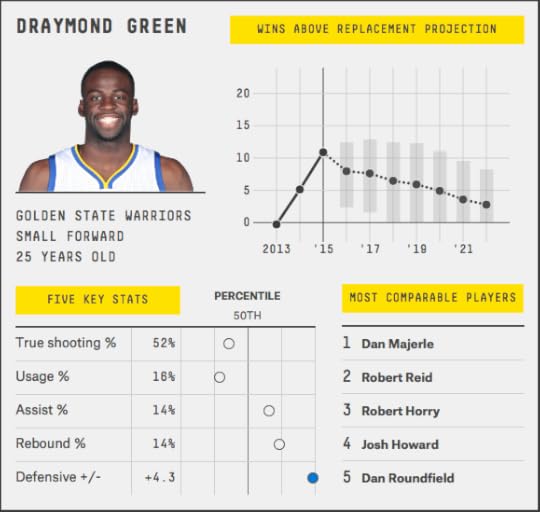
16. Draymond Green (36.4)
Arguably the breakout star of last season, Draymond Green is a defense-first bulldog with versatile offensive skills. A Dan Majerle comp beside a Robert Horry one? Yeah, it’s a strange pairing — but Green is an unusual player. The only caveat was that Green improved so much last year that he could be due for a pinch of reversion to the mean. Even so, CARMELO projects that he’ll produce $130 million worth of value to the Warriors over the next five seasons, a great return on his $85 million contract.
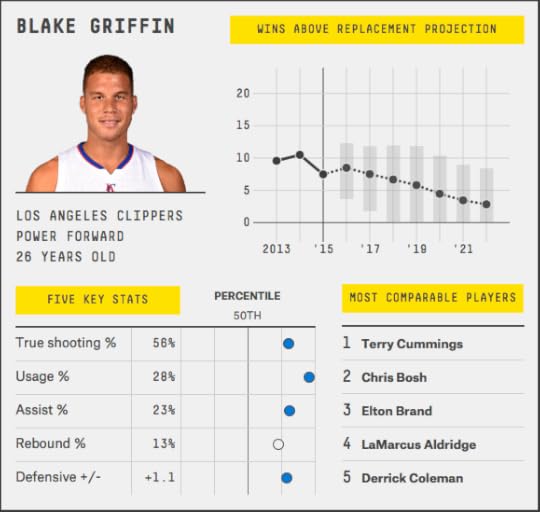
15. Blake Griffin (36.5)
Griffin would have ranked higher on this list a year ago. There are a few mildly troubling signs in his stats, particularly a decline in his rebound rate last season. Furthermore, a number of his comparables (such as Terry Cummings and Derrick Coleman) had fairly early career peaks. But let’s not get carried away. Although his fame may stem from his ferocious dunks, Griffin has evolved into a great all-around player whom every NBA team would love to have. He’s increasingly stretching opposing defenses with his outside shot, and he’s an underrated passer and defender.
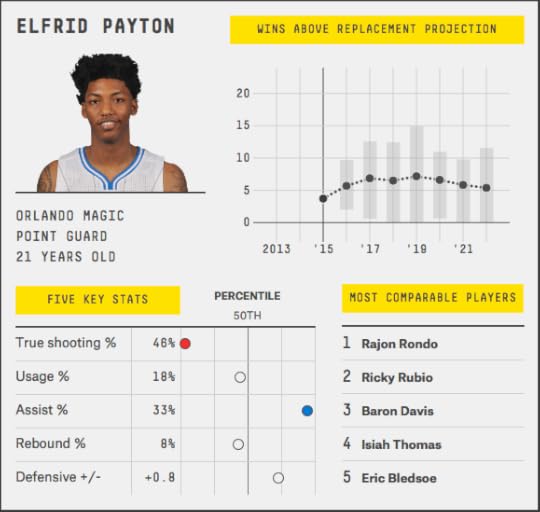
14. Elfrid Payton (38.0)
So we have bona fide stars like Jimmy Butler, Draymond Green, Blake Griffin … and then we have Elfrid Payton?!? Is this CARMELO’s version of PECOTA’s infamous Wily Mo Pena projection? Time will tell, but Payton logged almost 2,500 minutes as a 20-year-old rookie last year while flashing excellent passing and defensive skills. He can’t shoot at all yet, but one thing we’ve learned from CARMELO is that shooting skills sometimes take a few years to develop. If Payton develops some shooting touch, he could be the next Isiah Thomas; if he doesn’t, then for better or worse, he could be Ricky Rubio or Rajon Rondo.
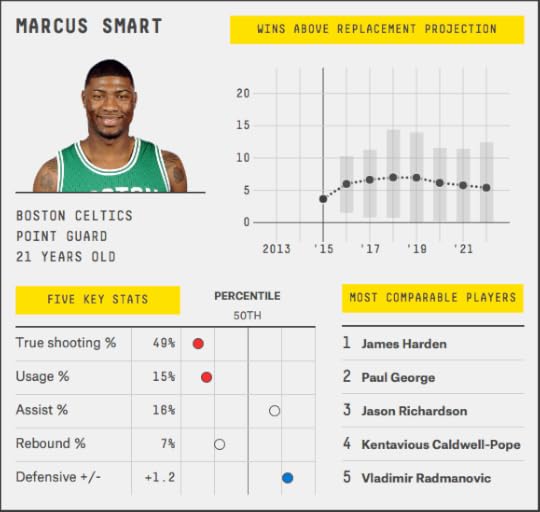
13. Marcus Smart (38.2)
Given how much CARMELO likes Payton, it’s not surprising that it likes Smart also. He fits a broadly similar profile: His shooting just isn’t there yet, but most of his other skills were already league-average or above last season, when he was just 20. The thing about players like these is that they can be superstars if their scoring develops (Smart’s No. 1 comp is James Harden, for instance) but reasonably valuable all-around players even if it doesn’t.
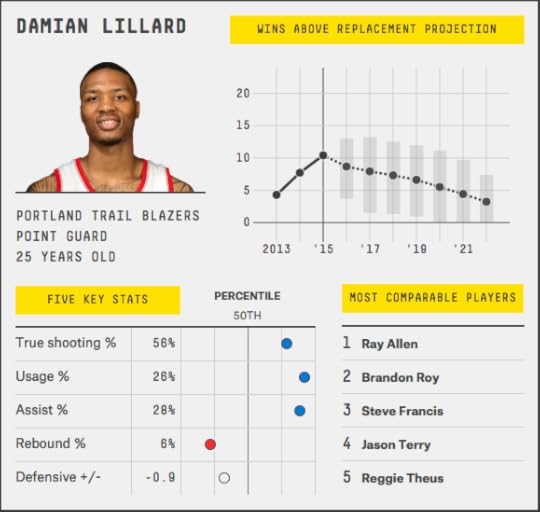
12. Damian Lillard (40.5)
Lillard is now the face of the franchise in Portland. Although he has the complete package on offense as a high-volume, efficient scorer and excellent passer, he’s a middling defender. Since high-usage point guards like Lillard want the ball in their hands as much as possible, the question is whether they’re good enough that you can build a championship-caliber roster around them. The results in Lillard’s case are mixed on that question, according to CARMELO. Lillard draws Steph Curry as a comp, but also Steve Francis and Gilbert Arenas.
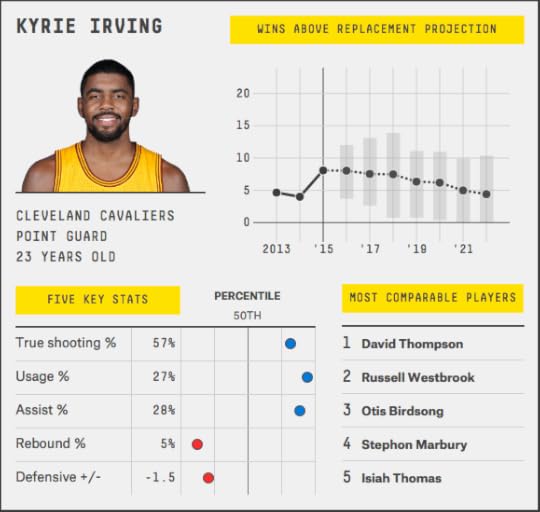
11. Kyrie Irving (40.6)
The upside is obvious: Irving has the killer first step and tight handle of Stephon Marbury. And while he’s not an all-time great passer like Isiah Thomas, he’s every bit as good a shooter. Plus, he’s just 23 years old this season. Advanced stats still don’t like his defense, however, and while Irving became a much more efficient offensive player last season, there’s some question about how much of that can be attributed to playing with LeBron and Love. Still, we have to give Kyrie the benefit of our doubt. More than a year ago, back in our unenlightened, pre-CARMELO days, we wrote that Irving probably wasn’t worth his $90 million extension. Now it looks like a good deal for the Cavs.
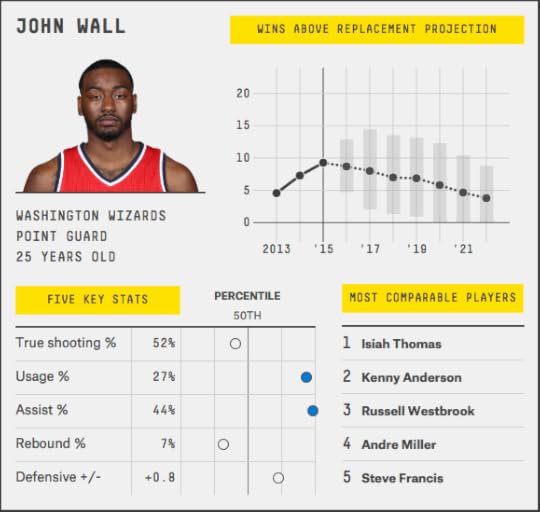
10. John Wall (41.1)
We wrote about Wall extensively in our introduction to CARMELO. Coming off his best season ever, and second All-Star nod, he’s entering what should be his peak. But the variance on his projection is high, with outcomes ranging from future MVP to overrated ball-hog.
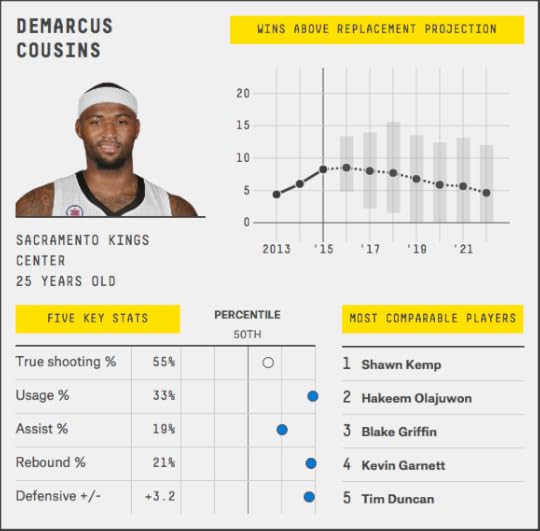
9. DeMarcus Cousins (42.6)
Speaking of high upside: Wow. Hakeem, Garnett, Duncan — those are some awfully exciting comps for Cousins. We even have a Shaquille O’Neal sighting on Boogie’s list (Shaq, who rarely appears as a CARMELO comparable because he was such an outlier, is Cousins’s No. 10 comp). But Cousins has never quite gelled into a superstar, as factors ranging from injuries to his frustration with Kings management have gotten in the way of his success. He can’t rest on his laurels because so far he’s just an average finisher around the rim, where he’ll need to improve before the Hakeem and Shaq comparisons bear out.
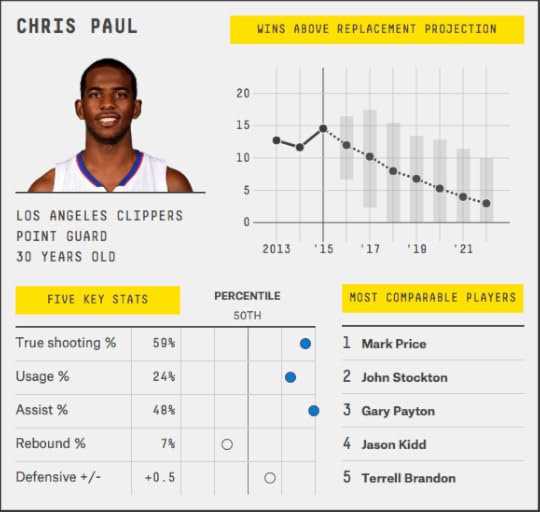
8. Chris Paul (46.3)
Paul is one of just two players in his 30s to make the top 10 (you’ll have no trouble guessing the other). The precedents are reasonably favorable here: Point guards tend to age well compared with players at other positions, and well-rounded players like Paul tend to age better than one-dimensional ones. Given his reputation for postseason struggles, however, we couldn’t help but notice that none of Paul’s top five comps (Mark Price, John Stockton, Gary Payton, Jason Kidd, Terrell Brandon) won an NBA title in his prime.4
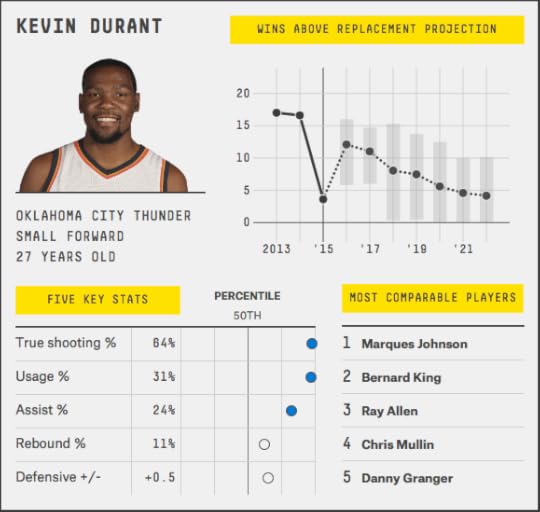
7. Kevin Durant (48.9)
The 2014 MVP winner was out with injuries most of last season. But even with the typical reduction in long-term value for a player who suffers a severe injury, Durant still ranks seventh on our list. At age 27, he remains a scoring monster — a lankier Bernard King, with Ray Allen’s shot. Royce Young said it best: “Not only does he want to re-establish his rightful place among the game’s most elite, but also this could possibly, maybe, potentially be his last chance at a title in Oklahoma City.”
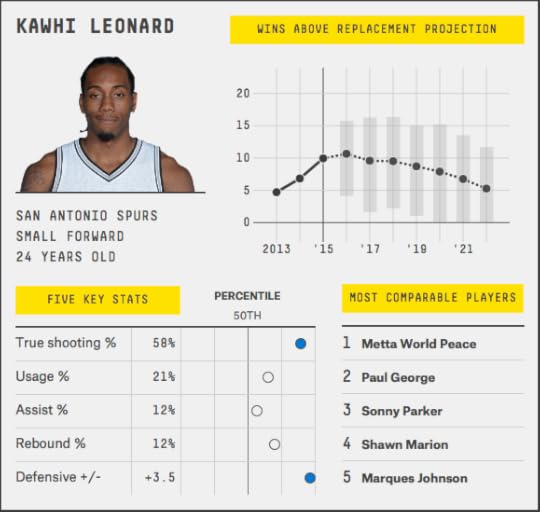
6. Kawhi Leonard (53)
We might call Leonard a sleeper — except that the rest of the basketball analysis community has woken up to his talents as the best lock-down wing in the game. Leonard won the Defensive Player of the Year award last season, and ESPN’s #NBARank list places him among the top 10 overall players in the game. Leonard’s offensive game has also developed, and, as Michael Wright notes, he could see fewer double-teams with LaMarcus Aldridge on the Spurs’ roster, leading to even better production. All of this is why Leonard is one of just eight players CARMELO labels as MVP candidates.
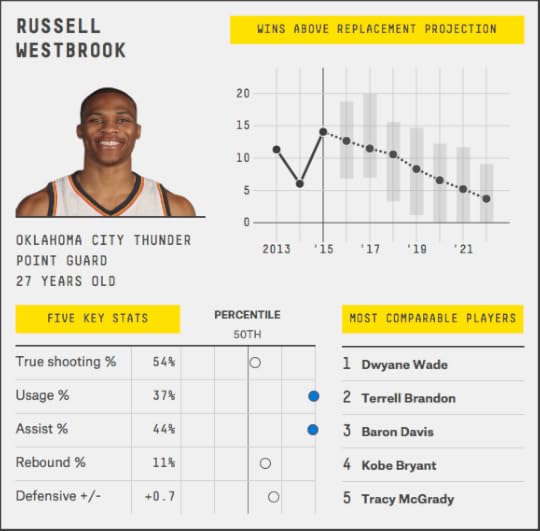
5. Russell Westbrook (54.9)
What is there to say? Westbrook averaged a triple-double per 100 possessions last season. And yet CARMELO gives him about a 40 percent chance of being even more valuable this year. His path to achieving that is obvious enough: by improving on his wildly entertaining (but often just plain wild) shot selection, which can sometimes overshadow the ridiculous box-score stats.

4. LeBron James (59.9)
LeBron is a multipositional freak of nature, as his Larry Bird-Magic Johnson-Charles Barkley comps demonstrate. (What about Michael Jordan? He’d rank high on LeBron’s list too if he hadn’t spent his age-30 season playing minor league baseball.) Even on the downward slope of his career, the King is still the King and projects to have several good years left. We know that some of you will object to any list that doesn’t have LeBron at No. 1, but consider the following: The only other 31-or-older player to make our long-term value list is Marc Gasol, and LeBron projects to have almost as much career value remaining as three Gasols put together.
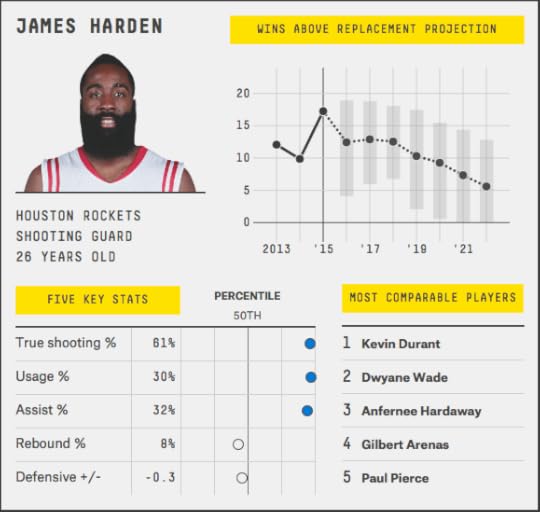
3. James Harden (64.8)
Harden’s stats were nearly as ridiculous as Westbrook’s last season. Compared with Westbrook, however, it’s not as clear how Harden can improve. He’s already an incredibly efficient offensive player. He can’t stay much healthier, having led the NBA in minutes played last year. So Harden might have to settle for 2014-15 as his career year unless … he keeps working on his defense, which while better than past seasons still rates as league average.
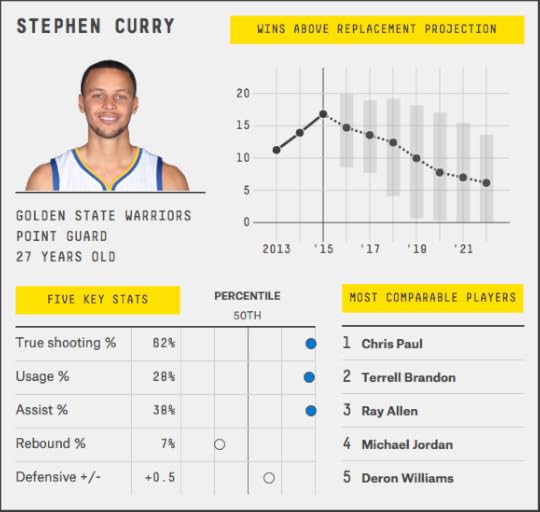
2. Stephen Curry (65.4)
Shocker: The 27-year-old reigning MVP has a bright future. An ultra-efficient shooter and a high-usage passing talent, Curry is a legitimate fusion of Ray Allen and Chris Paul — and is one of the few players to draw Michael Jordan as a top five comparable. But let’s pose the same question that we did for Westbrook and Harden: What might Curry do to become even better? The answer is probably to shoot a bit more. His usage rate is a couple of ticks behind Harden’s and well behind Westbrook’s and Jordan’s.
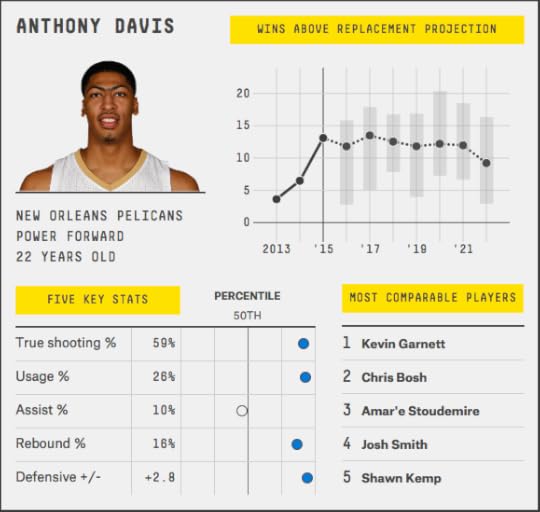
1. Anthony Davis (73.8)
The Brow combines Kevin Garnett’s ferociousness in rebounding and on defense with the stretch shooting ability of Chris Bosh. But even those names might understate his upside: There’s never been a player quite like him. (Garnett and Bosh, Davis’s top comparables, have just medium-high similarity scores when compared with him.) In other words, Davis will be terrorizing teams on both ends of the court for the foreseeable future: We’re just not quite sure how. The one thing to watch out for is injuries, which shorten big men’s careers more often than those of guards.
Below is a sortable table for all 572 players in our database, as of Oct. 27.

October 26, 2015
Can Ben Carson Really Take Out Donald Trump?
There’s a new front-runner in Iowa, and — by popular demand — we talked about what it means in this week’s 2016 election Slack chat. As always, the transcript below has been lightly edited.
micah (Micah Cohen, politics editor): Harry and Nate, Ben Carson has opened up a clear lead over Donald Trump in recent Iowa polls:
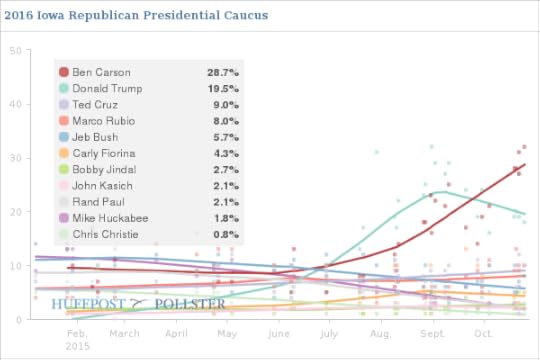
What to make of this? Is this real? Does this say more about Trump or Carson? Much of the media is spinning it as the start of Trump’s demise.
hjenten (Harry Enten, senior political writer): I think the first thing we know — clearly — is that the Des Moines Register, Quinnipiac University and any other poll showing Trump not winning are garbage polls. They just have no class.
But if “real” means that Carson would win if the caucuses were today, then yes, it is real.
natesilver (Nate Silver, editor in chief): Reality is just a social construct, man.
hjenten: But this is the first time we can say Trump is definitely trailing in a contest that will be important in three months.
micah: Right. And Carson seems like just the type of candidate who could win Iowa.
natesilver: It’s definitely “real” in the sense that Carson’s lead is too large across too many polls to be a sample-size fluke.
hjenten: Carson has 36 percent of born-again/evangelical support. That looks like Santorum’s support did in 2012 in terms of what is needed to win. Carson is clearly connecting with the more conservative voters out there.
micah: So answer this question: Is this more about Trump or Carson? Or both?
natesilver: Both, but yeah — I think it’s more about Carson. Like Harry said, he looks like he’s winning the Huckabee/Santorum vote, and his profile is similar to a lot of past Iowa winners.
micah: So this seems like a localized Iowa thing and not necessarily evidence that Trump will fade nationally.
natesilver: Not necessarily. But there is an argument that it’s bad news for Trump.
micah: What’s the argument?
natesilver: That Iowans are paying more attention to the race than people elsewhere in the country, so they may be early adopters of trends we’ll see elsewhere. In other words, once Trump starts getting Iowa-type scrutiny in other states, he might fade.
hjenten: On average, Trump’s net favorability is +18 percentage points in the last four Iowa polls. That’s basically the same as it was the last time the same four pollsters were in the field (late August/early September), when it was +22. But there’s always been this sort of discord between Trump’s topline (horse race) numbers and his net favorability. We’d have thought, based off his net favorability, that he wouldn’t be leading the horse race.
Carson’s net favorability is +77 points! He’s much better liked. Net favorability isn’t always linked to doing the best in the horse race, but better-liked candidates generally do better. So I’ve always been skeptical of Trump’s numbers.
micah: Wait — but the point is Trump’s topline numbers have dropped in Iowa, but his net favorability hasn’t?
hjenten: To a degree, but Trump’s net favorability wasn’t good to start off with. What’s finally happened, it seems, is that as voters are paying more attention, the better-liked Carson has jumped in front. Trump could remain just as popular as he is now and still lose — because he isn’t that popular. Voters just need to pay attention to the other candidates.
natesilver: What’s interesting is that Carson doesn’t have all that much of a campaign operation in Iowa. Nor has he made all that many visits there.
micah: He’s on a book tour right now!
hjenten: Though Carson has always done fairly well in Iowa.
micah: Here’s the other thing: If you look at their trend lines in Iowa, Carson’s and Trump’s support mostly moved in unison until about a month ago, when Carson just shot up. So what happened?
natesilver: Well, as I’ve written before, I’m not sure that Trump and Carson have all that much in common. Carson seems to be a more familiar sort of candidate — high floor, low ceiling guy who appeals to evangelicals. Trump is more sui generis but vaguely resembles more secular candidates like Newt Gingrich who didn’t necessarily do that well in Iowa.
hjenten: Yes, this is the common mistake that folks make. They’re both outsiders, therefore they are the same. They aren’t the same.
micah: Another question: We got a string of non-partisan live-interview polls that found Carson leading Trump, but what did you make of that CBS News/YouGov poll showing them tied at 27 percent?
hjenten: Let’s get a little nerdy here shall we?
natesilver: YES.
hjenten: This has been one of the more interesting Trump phenomena; I believe Jon Robinson first discovered that Trump does better in non-live-interview polls. The belief being that people were afraid to admit they were voting for Trump to an actual person. But YouGov state polls, which are conducted online, really exacerbate this issue. So the question is whether people are afraid to admit they’re voting for Trump and/or whether YouGov simply doesn’t have the mechanism to get a sample that is representative of the primary electorates. You see this on the Democratic side, with Bernie Sanders doing significantly better in YouGov surveys than in other polls.
micah: Why can’t YouGov get a representative sample in these state polls?
hjenten: Because YouGov uses a volunteer sample. In general elections, if you have party identification, then you can just weight by that, but in a primary, you don’t. So other demographic factors become a lot more important. YouGov has taken some steps to control for that, but it’s fairly clear that some of these numbers are well out of line with other polls. Trump at 38 percent in New Hampshire? No other pollster besides YouGov has ever had him that high.
natesilver: Yeah, Occam’s razor is that if you take methodological shortcuts, then you’re probably in the wrong when you differ substantially from other polls. Plus, there’s some evidence that IVR (robopolls) and online polls herd toward traditional polls in the primaries.
I don’t want to completely rag on online polls — YouGov is better than a lot of crap like Zogby Interactive. And I’d trust online polls before IVR at this point. But still, the Iowa caucuses are a tricky thing to poll, and you have a lot of high-quality pollsters in the state who have a lot of experience with measuring the electorate in the state. They’re finding Carson ahead.
Plus, the idea that Trump voters would be ashamed to express their support for him in live-interview polls (some sort of a Bradley effect, in other words) seems speculative. It’s not as though Trump supporters are reluctant to make themselves heard. And it’s not as though voters in Iowa are reluctant to express “politically incorrect” positions.
micah: OK, so Carson is leading in Iowa — how does that affect the rest of the field? Is that good/bad news for anyone?
hjenten: I mean, it does show that some normal rules of GOP primaries still apply — that there can be a candidate who uses born-again/evangelical support to take a lead in Iowa. And that to me is good news for Ted Cruz or Bobby Jindal
micah: Isn’t it also better for Marco Rubio, Jeb Bush and John Kasich? Carson seems like the type of candidate who can do well in Iowa but not New Hampshire — isn’t it better for the establishment candidates to have that type of person win Iowa (short of winning the state themselves, of course).
hjenten: Agreed — Rubio is now tied for third with Cruz in Iowa. If Trump falls a little more (which seems completely possible), Rubio could take second in Iowa, and then boom! Hasn’t happened yet though.
natesilver: Before we talk about a return to normalcy, we should point out that Trump is still ahead in New Hampshire. What if Carson wins Iowa and Trump or Cruz or someone wins New Hampshire?
micah: I have no idea. Then you’re talking about a prolonged contest, right?
hjenten: To me, the more interesting question is what happens when it’s clear that Trump is no longer ahead everywhere. His net favorability argues that he should be far lower in the polls, but he is converting a much higher rate of people who have a favorable view of him into “votes.” If he starts falling in one place, does the entire enterprise just fall apart?
natesilver: This all seems a bit overeager. The media narrative about Trump is in disarray right now. If you look at the Iowa polls, he’s clearly fallen behind Carson. If you look at national polls, he’s still ahead (and, in fact, seems to have recovered some of the points he lost after the previous debate). So voters go back and forth between reading stories implying that Trump is doomed and those that imply he’s invincible. I wonder if that dynamic doesn’t help him a bit. It seems like he’s totally Teflon when the real story is more that there isn’t all that much news in the campaign and the media is over-interpreting noisy data.
micah: They can find both in one article if they read FiveThirtyEight. But IDK, it seems like you’re overthinking this: Trump has lost the lead in Iowa = bad for Trump. Not ruinous, but bad
hjenten: Trump has lost a lead.
micah: Yeah, Nate, it doesn’t seem that complicated.
hjenten: Yeah.
natesilver: He’s lost a lead, but that just creates more opportunities for “LOLZ you can’t predict Trump!!!!” later when he happens to get a sequence of good polls instead. Here’s what almost certainly would hurt Trump. Forget the polls. Finishing third place or something in Iowa would hurt Trump.
hjenten: Well sure.
micah: Does Trump need Iowa?
natesilver: Well, keep in mind that neither of us thinks he’s very likely to win the nomination in the first place. But unless he wins Iowa, I think it becomes even less likely.
hjenten: Yes, Trump needs winning. Trump is all about winning.
natesilver: You can’t spell “DONALD TRUMP IS A WINNER!” without T-R-U-M-P.
hjenten: That’s right. If I can, I’d like to quote myself from last night:
I love The Donald / His polls are so fantastic / When not, they're biased #odestoDonaldTrump2016
— Harry Enten (@ForecasterEnten) October 26, 2015
natesilver: Here’s the other thing: People seem to be assuming that we’ll be left with one “insurgent” candidate against a bevy of establishment candidates. For all we know, it could wind up being the reverse. Two out of the three of Cruz/Carson/Trump survive after Iowa and New Hampshire. Meanwhile, just one establishment-lane candidate is left.
hjenten: It could be Marco Rubio vs. the non-establishment. It could be, dare I say, John Kasich? Or it could be Rubio vs. Cruz vs. Carson. Again, we’re dealing with a small sample size with concern to primaries under the current system. It’s difficult to draw hard lessons from history.
natesilver: WHAT ABOUT JEB, HARRY? IS HE TOAST?
hjenten: I don’t think he is toast, but I think he’s in a lot of trouble. We can talk about Jeb! after the debate this week.
Check out all of our 2016 election coverage.

October 21, 2015
How The Media Blew The Biden Story
Now and then over the years, I’ve been fortunate enough to extend a job offer for someone to come work with me. Being a huge dork, I’ll usually speculate about the candidate’s likelihood of accepting the position. I don’t bat 1.000 on my predictions, but one simple rule has proven reliable the majority of the time: If I can honestly say I’m offering a candidate a better job than the one they currently have, they almost always accept the offer. If I can’t say that with a straight face, they usually don’t.
When you’re in the midst of making someone a job offer, you’re privy to a lot of “inside information” about the candidate: what their mood is during interviews, for example, or how happy they seem to be with their current employer. But it’s easy to get carried away with those things. Unless the “inside information” is weighed very carefully, it often just leads you astray. I was reminded of this by today’s news that Vice President Joe Biden will not seek the Democratic nomination for president. Here at FiveThirtyEight, we’ve been skeptical of Biden’s potential candidacy for a long time, even as on-the-ground reporting — almost always relying on anonymous sources or named sources with tenuous connections to Biden — repeatedly insisted that Biden was likely to run.
The reason for our skepticism was twofold. First, Biden has a pretty good job now: vice president. While I have no doubt that he’d like to be president, the job of being a failed presidential candidate isn’t such a great one. And in all likelihood, that’s what a Biden candidacy would have amounted to. Maybe Biden’s campaign would have ended quickly, as past late-entry campaigns (Fred Thompson, Wesley Clark) often have. Maybe it would have persisted for months and bitterly divided Democrats. But as my colleague Harry Enten explained, Biden would have been a substantial underdog given that Hillary Clinton is well ahead with both rank-and-file voters and the Democratic establishment, Sen. Bernie Sanders is Democrats’ clear second choice, Biden doesn’t have an obvious constituency within the party, and his campaign would be getting off to a very late start.
The second reason is that there was some non-anonymous information on what Democratic insiders were thinking, and it suggested there wasn’t much appetite for a Biden bid. Clinton has received a record-setting number of endorsements from Democratic lawmakers and continued to rack them up while Biden was contemplating his bid. Biden, by contrast, was endorsed only by the governor of Delaware and two of the three members of Delaware’s congressional delegation. Meanwhile, surveys of Democratic insiders in Iowa and New Hampshire conducted by Politico found a lukewarm reaction to a Biden bid.
Although these methods are not quite as rigorous as scientific polls, they at least reflect an effort to be comprehensive instead of potentially cherry-picking the sources they report on. A Biden run would be a great story for the media — it would get to sit back and watch the fisticuffs between Biden and Clinton, who is otherwise something of a dull, predictable story (“inevitability” is boring). That probably biases the media toward reporting on the few Democratic insiders who would have liked to see a Biden bid, and ignoring the large majority who were satisfied with Clinton.
Quick reaction: Biden’s out.I don’t mean to paint the whole mainstream media with the same brush. All the while, there have been a few stories (see this article from Politico’s Glenn Thrush or this one from the Los Angeles Times’s Mike Memoli, for example) that relied on traditional reporting but mixed it with the proper amount of skepticism about Biden’s intentions — and wound up getting the story right. And there was this story, also from Politico, suggesting that the links between Biden and the “Draft Biden” super PAC were nebulous, and that Biden might create a different super PAC were he to launch his bid. That seems important, given that “Draft Biden” sources figured prominently in stories suggesting that Biden would run. Perhaps rather than serving as a reliable indicator for his intentions, “Draft Biden” was trying to goad Biden into the race instead.
In another sense, “Draft Biden” and the media were complicit in running a “shadow campaign” on Biden’s behalf, gauging interest in a Biden entry through continual and deliberate leaks, and eventually finding it wanting. All the while, the reporting was far too credulous about Biden’s strengths as a candidate and the probability that he would formally declare for the race. As is often the case, sketchily sourced “inside information” proved no more reliable than other types of gossip.

October 20, 2015
Donald Trump Is Doomed And/Or Invincible
You know who we haven’t talked about in a while? Donald Trump. Trump last appeared in a FiveThirtyEight headline on Oct. 2! That cannot stand. So for this week’s 2016 election Slack chat, we’re talking Trump. As always, the transcript below has been lightly edited.
micah (Micah Cohen, politics editor): So what’s going on with Donald Trump? He fell in national polls after the second Republican debate, but that fall was brief and small, and he’s still in the high 20s.
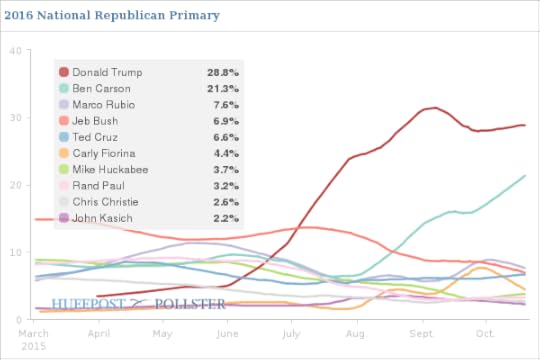
He has now led in the polls since the first week of July, and we’ve had several rounds of “this is the end of Trump” stories that proved off. We’ve been pretty skeptical of Trump’s chances to win the Republican nomination, but has his durability changed in your view?
hjenten (Harry Enten, senior politics writer): Trump is ahead and was ahead. He has never trailed nationally outside of that IBD/TIPP poll.
But here’s an important thing to keep in mind about Trump: We’ve been skeptical of Trump because even as he has led, he still hasn’t shown the ability to cobble together enough GOP voters to win after candidates start dropping out. In two of the three national polls out in the last week, it’s Ben Carson, not Trump, who led in first and second choice combined.
natesilver (Nate Silver, editor in chief): So, my theory of the case is still contained in the “Six Stages Of Doom” article I wrote about Trump in August. That suggests that it’s still very early. Trump has perhaps survived Stage 1, “Free-for-all.” It seems clear that his success in the polls is not purely a result of media coverage — although media coverage plays a very important part of it, as we can discuss later on. But we haven’t really entered Stage 2 yet, which is “heightened scrutiny.” That’s when voters start to pay more attention to the race and polls start to measure likely voters instead of all Republican-ish adults.
It’s interesting that Trump’s numbers were rattled a bit after each of the first two debates, for instance, since that’s a time when the candidates were on a more level playing field.
tl;dr: Sure, his chances look a little better than they did a month or so ago. But I’m not sure anything all that fundamental has changed, and the fundamentals would imply his odds of winning the nomination are still pretty darn low.
micah: Let’s try to get a more exact sense of where we see things. What were Trump’s chances of winning the nomination on Sept. 1? And what do you think they are now?
hjenten: 2 percent and 4 percent.
micah: TRUMP DOUBLES CHANCES OF WINNING!
natesilver: Trump’s chances of winning the nomination are exactly 7.1459814514128405 percent. Just kidding. I’m somewhere in the high single digits.
micah: And on Sept. 1?
natesilver: Well, I put his chances at 2 percent in that “stages of doom” article, which lays out a procedure for how you’d calculate them. If he has cleared Stage 1, his chances would double, to 4 percent.
micah: Harry’s dead on.
natesilver: But I’d round up a little bit higher than that because I think he’s made some progress on some of the later stages. For instance, his favorability ratings — although still potentially a liability down the road — have improved some.
hjenten: I think that “high single digits” is awfully high. Mitt Romney had a better shot of winning on Election Day 2012 than Trump now.
natesilver: But there’s a lot of existential uncertainty here. If you’re being purely empirical — well, nobody quite like Trump has won a party nomination before, or even come all that close to it. So there’s some universe where his chances are 0 percent.
hjenten: Most of the uncertainty for me is not whether Trump loses, but when he loses.
natesilver: I agree. And look, to some extent 4 percent vs 7 percent is an angels-dancing-on-pinheads debate.
hjenten: As for favorability, let’s point out that his favorable rating is the same now as it was in August. You can see that in the Monmouth poll out Tuesday. (It’s up from June and July.)
natesilver: Some of what caused the big uptick in Trump’s favorability ratings in the spring and summer may have been that he went from someone who wasn’t identified with a party to someone who began calling himself a Republican. Interestingly, his overall favorability ratings (i.e. with Democrats plus Republicans plus independents) have been extremely steady throughout the campaign. Nonetheless, one of the lessons of Trump is that favorability ratings can be volatile too.
hjenten: Yes, it can be very volatile. We’ve seen it move around. It probably spiked before the second debate. I think based on the data that he’s halted his post-second-debate slide, but he’s off his peak.
micah: That seems right …
natesilver: So, I think we might want to contemplate that very pattern, which is that Trump fell a bit in the polls after each of the first two debates before recovering some. That was clearer after the second debate than the first one, but probably true for the first one, too, if you look carefully enough.
micah: And you see that as foreshadowing? Do the debates have anything in common with later stages of the primary?
hjenten: I think they do, in so far as it’s the one time when more people are paying attention to politics.
natesilver: But the voters who participate in Iowa, New Hampshire and other early primary states will have paid a LOT of attention by the time they vote. It’s not perfect, but you can look at a Google Trends chart of when interest in the 2012 primary campaign spiked, for example. It was about seven times higher in January, February and March than it was in October.

micah: I’m not sure what point you’re making.
natesilver: The point is that “campaign time” is not linear. We’re still in the functional equivalent of the top of the second inning.
micah: But what do Trump’s post-debate dips suggest to you?
natesilver: That possibly his numbers will suffer as he faces more scrutiny from voters. And as the media coverage evens out a bit. OTOH, the steady state where nothing much is happening in the campaign seems helpful to Trump, who is able to turn empty news cycles into Trumpian ones.
hjenten: I should point out that it’s clear that Trump has suffered at least a little bit, even WITH the debates relatively far in the rearview mirror. For instance, it’s clear now that Trump has weaker support among women than men. It’s clear that better-educated Republican voters are less likely to support his campaign — stuff you might have expected after his earlier controversial comments.
Back when he started leading in the polls, Trump’s numbers were strong across the board. They’re still good, but they’re not uniformly good. It’s as if he’s become more of a traditional candidate, and the rules of politics now apply to him.
natesilver: Maybe. But I’m more on the side of saying that nothing much has changed in the campaign, so we shouldn’t necessarily expect dramatic changes in Trump’s numbers. For that matter, I don’t take for granted that he’s going to fall to zero, or into the single digits. Some Trump-like candidates have won 20 or 25 or 30 percent of the vote before, especially in Iowa and New Hampshire.
hjenten: That’s why I look at the first and second choice numbers, to get an idea of the ceiling.
micah: Is it safe to say we’ve seen Trump’s ceiling?
hjenten: No. Not in my mind.
natesilver: I don’t think there are any totally safe predictions about what Trump’s polling will look like in the near term.
micah: And how much of Trump’s durability has to do with the other candidates? It’s a bit of a chicken-and-egg thing, but no one else is catching on it seems, right?
natesilver: Carly Fiorina’s rise and fall is interesting. She doesn’t seem to have a way to stay in the news cycle in between debates.
micah: Right … Carson is basically co-leading with Trump, but everyone else has fallen into a pack in the high single digits at best. And even beyond the polls, no one seems to be getting much favorable buzz or much of anything.
natesilver: Yeah. It’s not just that support is divided but that attention is divided, too.
hjenten: Look at the Democratic side. Note how Hillary Clinton has gone up in the polls with positive press coverage. Notice how she has led now in two of the three post-debate polls in New Hampshire. Press coverage means a lot. When you get down to just one or two folks to concentrate on in addition to Trump, that should hurt him significantly.
natesilver: Certainly, the Democratic polls over the past couple of weeks have made political scientists and “data journalists” look smart. But it’s possible that the Republican Party is a different beast.
micah: It does kind of all go back to something we talked about early on in the summer: Even without Scott Walker and Ricky Perry, this is a historically huge GOP field, and that fact is underappreciated by the media.
natesilver: It’s historically huge, and also the establishment hasn’t really settled on a candidate.
hjenten: Of course, it’s possible that this is a different beast. We’ve had 12 open primaries (i.e. no incumbent president running for the nomination) since 1980. It’s a small sample size, but I don’t know how we can say the system is broken when there is no clear party-actor favorite. Perhaps that gives Trump a better shot, but it also may mean (and in my mind, probably does mean) that Trump is adios goodbye when they do settle on the anti-Trump.
Trump for the record still has 0 endorsement points.
micah: Right, part of me wonders if the Trump fade won’t come until the establishment rallies behind a candidate.
natesilver: Even if “this time is different,” that doesn’t necessarily culminate in Trump’s nomination. He has a lot of other liabilities, such as still-just-lukewarm favorability ratings, the lack of a traditional campaign organization, and a bunch of policy positions that are at odds with those of Republican primary voters.
hjenten: If the system is broken — or at least different — then it could benefit someone besides Trump. That’s part of the reason that I think Ted Cruz has a shot.
natesilver: Yeah. I’m more of a Trump skeptic than a Party Decides truther. Maybe the Republican establishment is partly but not entirely broken, and that results in a messy nomination process, but Trump still doesn’t win. About the only thing the Republican establishment agrees upon is that it doesn’t want to nominate Trump.
There’s also this: “Mr. Trump spent more on hats and T-shirts — about $678,000 — than he did on field staff and offices in Iowa, New Hampshire and South Carolina, where his expenses totaled just $353,363.”
hjenten: That’s the thing here: Candidacies — even the strongest of candidacies — hit bumps in the road. Al Gore lost his New Hampshire lead in 2000. George W. Bush lost New Hampshire in 2000. Trump hasn’t shown any willingness to spend money on organization and ads. If he starts to spend on advertising when all the other candidates’ ads are on the air, then I’ll think, “well Harry, you might have to eat your words.”
Trump hasn’t been knocked down yet. And when he has faced his opponents in debates, he has been taken down a peg or two. Let’s see what happens as the campaign continues and shots are fired on television beyond just the nightly cable news talk show stuff.

2015-16 NBA Preview: Andrew Wiggins Might Be The Next Carmelo
We’re inaugurating our NBA player projection system, CARMELO , with 2015-16 season previews for every team in the league. Check out the teams we’ve already previewed here . Learn more about CARMELO here .
The Minnesota Timberwolves are very likely to improve on their 16-66 record — and very unlikely to make the playoffs. Beyond that, almost anything is possible. If everything goes well, we could be mentioning the Wolves in the same breath as the New Orleans Pelicans in next year’s CARMELO preview: a team that’s on the verge of becoming a title contender. There really is that much upside on the roster among Andrew Wiggins, Karl-Anthony Towns and Ricky Rubio.
But they could also be a total disaster. For now the Wolves are a collection of misfit toys, full of players who are a little too young, a little too old, a little too one-dimensional, a little too injury-prone. They also don’t mesh particularly well together, leading to trouble finding good looks on offense and disorganized, lackadaisical defense.
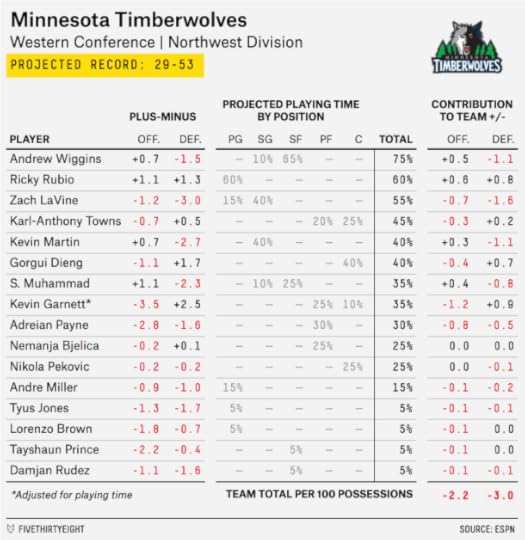
So take CARMELO’s 29-53 projected record for the Wolves with a grain of salt. It’s a rough guess. More to the point, it doesn’t matter all that much. If the Timberwolves somehow hang around the .500 mark because of surprisingly good last-gasp seasons from veterans like Kevin Garnett and Kevin Martin, it’s not going to do much beyond worsen their lottery position. This year is more about how their young players develop, instead. No player is more important to their future than Wiggins, so we’ll start our CARMELO-guided tour of the roster with him:

In many respects, we created our CARMELO projection system because we were curious about players like Wiggins. On the one hand, he was a regular starter in the league at age 19, which is usually a very good sign. On the other hand, though Wiggins scored 16.9 points per game, he was one of the least efficient regulars in the NBA according to advanced statistics such as Real Plus-Minus. Our assessments of Wiggins last year ranged from decidedly pessimistic to guardedly optimistic, often sparking ire from T-Wolves fans who were sure they were watching the league’s next superstar.
But that was before CARMELO! Now we have CARMELO, and it’s on the optimistic side. CARMELO thinks Andrew Wiggins has a chance to be the next … Carmelo Anthony.
Anthony, Wiggins’s No. 1 comparable, is a good example of what Wiggins’s upside could look like. In Anthony’s rookie year in 2003-04, he was a high-volume but fairly low-efficiency scorer, averaging 21 points per game on 43 percent shooting. Middling scoring efficiency is one of the more forgivable flaws for a young player, however. Both shooting technique and shot selection can (and often do) improve with practice and experience, especially for a player on a young, rebuilding team whose teammates are improving alongside him. Some of CARMELO’s breakout picks this year, like Marcus Smart and Elfrid Payton, fit into exactly this category.
But whereas CARMELO is enamored of Smart and Payton, it’s more tentative in its affection toward Wiggins. The reason is his defense, which cost the T-Wolves about 2 points per 100 possessions while Wiggins was on the floor last season. Wiggins’s D will likely improve, but he could wind up a lot like Anthony: very good, but between mediocre defense and average efficiency, not quite as good as his box score stats suggest.

Ricky Rubio is one of the NBA’s bigger outliers, ranking near the top or bottom of just about every statistical category: stellar passer, but turns the ball over a ton and is one of the league’s least efficient shooters. He is a good defender and is younger than you might think (25), having been drafted by the Timberwolves in 2009 when he was just 18, so he still has time to improve. Indeed, CARMELO’s projection for Rubio is fairly optimistic, relying on precedents like Jason Kidd and Rod Strickland, who developed just enough scoring touch to become cornerstone players.

CARMELO likes the No. 2 pick in last June’s draft, D’Angelo Russell, slightly better than No. 1 Karl-Anthony Towns. But this is nonetheless a pretty good projection for Towns. True, his top two comparables (Andrew Bennett and Greg Oden) couldn’t be more discouraging, but that conceals some favorable names (Chris Bosh, DeMarcus Cousins, Anthony Davis) just a bit further down his list. A plus with players like Towns is that they can be average-or-better defenders almost as soon as they enter the league, even as they’re figuring out their offensive games.

Although CARMELO sees high reward — coupled with high risk — for Wiggins, Rubio and Towns, it’s less convinced that Zach LaVine will ever become an above-average NBA player. As my Grantland colleague Zach Lowe explains, LaVine was simply overmatched last year, forced into playing more than 1,900 minutes as a pro after having been only a modestly effective amateur at UCLA. LaVine could turn into a league-average player like Monta Ellis — his No. 6 comparable — but even rebuilding teams like the T-Wolves will invest only so many resources in trying to develop the next Monta Ellis.

Oddly enough, the Wolves have a fair amount of frontcourt depth, so Gorgui Dieng could see his playing time decrease despite being one of Minnesota’s more effective players last year. He has a relatively common profile for a big man, and one that tends not to age all that well: good defender, excellent shot-blocker, but limited by his inability to create his own shots.

Kevin Martin has always been a miserable defender, so his offensive game has to be superlative for him to be a worthwhile rotation player. Instead, he’s showing signs of age, having posted his lowest true shooting percentage since his rookie season last year. Martin would have more value as a 10-minutes-per-game offensive sparkplug off the bench for a contending club than as someone who’s still logging starter’s minutes.
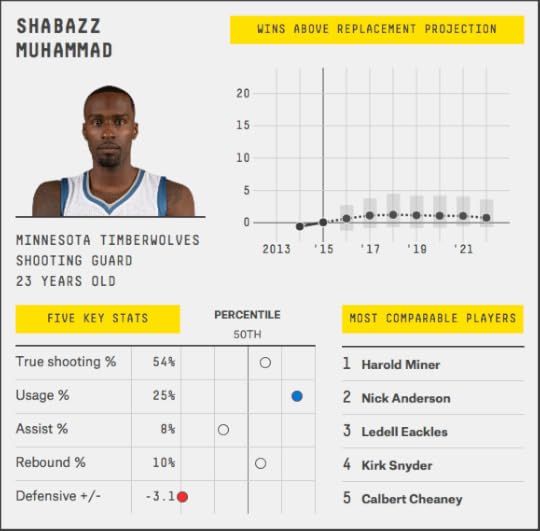
Sometimes CARMELO comparables are eerily resonant. Shabazz Muhammad, a former high school slam-dunk champion, draws comps including Harold Miner (his No. 1 overall comparable) and Cedric Ceballos (No. 6). Both Miner and Ceballos won the NBA slam-dunk contest but were minus defenders and otherwise never quite gelled as NBA players. At 23 this season, Muhammad is far from a lost cause, but the Wolves have a lot of other projects who might be higher on their priority list.
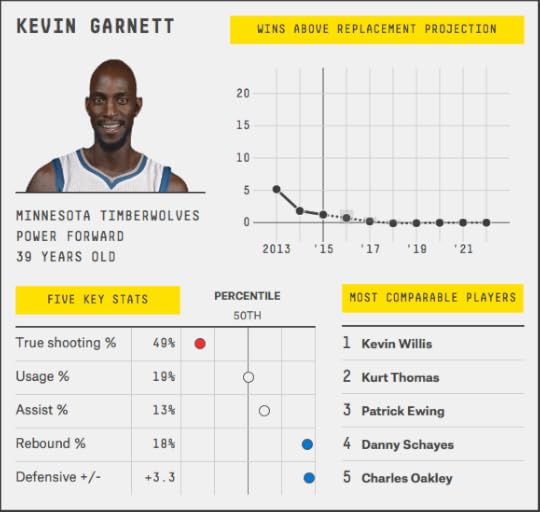
CARMELO slaps the “scrappy veteran” label on Kevin Garnett, which seems to woefully underbill his accomplishments as a 15-time All-Star. But that’s what Garnett is at this point, with his defense and rebounding skills still largely intact but no longer much durability or ability to contribute on the offensive end. His return to Minnesota as a sort of player-coach is a nice story, but he has just enough left that contending teams could eye him for frontcourt depth down the stretch.
Read more:
All our NBA player projections
All our 2015-16 NBA Previews

October 14, 2015
Did The Democratic Debate Change The Odds?
The first Democratic debate is in the books, so we surveyed the state of the Democratic primary in this week’s 2016 election Slack chat. As always, the transcript below has been lightly edited.
micah (Micah Cohen, politics editor): We’re going to play our traditional post-debate game, where we buy/sell/hold the conventional wisdom — as represented by the candidates’ chances of winning the nomination on PredictWise.
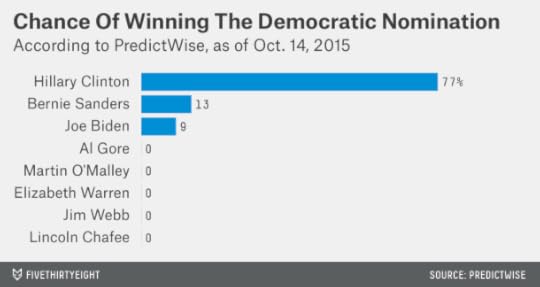
Before we get to the game though, what was your favorite moment from the debate Tuesday night?
faraic (Farai Chideya, senior writer): What I call the “bro hug” — in this case gender-neutral — between Hillary Clinton and Bernie Sanders. (Really more of a “bro/sis shake/hug.”) Remember there was a Donald Trump-Jeb Bush bro hug at the GOP debate.
natesilver (Nate Silver, editor in chief): Probably when I saw this, then remembered Lincoln Chafee had once been elected governor of an entire state.
hjenten (Harry Enten, senior political writer): DAMN! That was mine.
faraic: That was a lot of over-emoting.
hjenten: No one has explained to me what the heck Lincoln Chafee is doing on that stage. If I’m a Larry Lessig fan, I gotta be going bonkers that Chafee was up there and not Lessig. The fact that he was let on that debate stage should be a scandal of some sort.
natesilver: But honestly my favorite part was afterward, when all these news outlets who had pushed the “Clinton in disarray!” meme were tripping over themselves to praise her performance.
micah: That brings us to Hillary Clinton; PredictWise has her chances of winning the Democratic nomination at 77 percent — buy/sell/hold?
natesilver: I know what Harry is going to say.
hjenten: I’m selling! Just kidding. I’m buying. I’m buying hard. I’ll even buy Nate a few shares at that price.
faraic: Buy.
natesilver: I’d buy too, although she’s gone up quite a bit at Predictwise over the last 24 hours.
hjenten: Yes, I think she was at 69 or 70 percent not too long ago. I have no clue what those bettors were thinking, but there you have it.
natesilver: I think she was somewhat undervalued before the debate. The fundamental reason being that, if Clinton doesn’t win the Democratic nomination, someone else has to, and it’s not quite clear who that person might be. I’m not convinced that Tuesday night changed much about the reality of the race, however. Clinton was winning before. She’s still winning.
hjenten: The only thing the debate may have changed in my mind is that I’m more confident Joe Biden won’t get in the race (I really have no clue though).
faraic: Clinton’s winning much more publicly now. And apparently, without too much fuss from her competition. It seemed a lot of vying for the veepstakes.
micah: That’s interesting: The debate forced the media more in line with the fundamentals of the race (which show Clinton as the clear favorite)? Basically, the media narrative is now right but for the wrong reasons?
natesilver: Micah, I’m not sure if the “narrative is now right but for the wrong reasons” so much as that it was wronger before and had to overcorrect to get back on course. A lot of the political science view of debates is that they bring the race more in line with “fundamentals,” which favor Clinton.
faraic: Remember when then-Senator Obama said, “You’re likable enough, Hillary” in a debate during the 2008 campaign? In the debate, Clinton did not run on likability. She did not act forced. She acted powerful and she acted like she didn’t give a crap about being too likable. Not that she was un-likable, but she just didn’t focus on all the narratives that her campaign has been pushing about her mother and her early years.
natesilver: Farai makes an important point, which is that the Clinton campaign has been reasonably good about not overreacting to the media narrative, at least as far as I can tell. They’re not trying to “win the morning”, so to speak, which is a trap a lot of campaigns fall into.
hjenten: Playing the long-game, as well they should be.
micah: There is some short game importance attached to the debate though.
hjenten: The short-game matters with Biden, if you think Clinton’s performance will dissuade him from running. But the fact that he didn’t show up Tuesday night speaks volumes to me about what he’s thinking.
micah: And you all think Clinton’s strong performance influences Biden?
faraic: It should. It’s awfully hard to ride in to save the day when the day doesn’t seem to need saving.
micah: Yeah, that about perfectly captures the problem with all the Biden talk
faraic: The lovefest/party unity between Sanders and Clinton is also a marked difference from the GOP race. The GOP race is like MMA and last night’s debate was more like badminton.
hjenten: Croquet I’d say.
natesilver: Yeah, the debate did real damage to another bullshit meme, which is linking the Democratic and Republican races together under the same narrative umbrella. The Democrats are quite … arrayed right now. The Republicans aren’t.
hjenten: Can I note that the harshest attack of the night came from Clinton? It was on guns against Sanders. That, to me, suggests Sanders isn’t going to go after Clinton in the way he would need to in order to win.
faraic: Yes, Sanders’ gun retorts didn’t come across as sufficient to the tragedies of the day. If he was going to offer a rationale for his position, it needed more of a perspective than just that he represents rural voters.
micah: So let’s officially turn to Sanders. PredictWise has him with a 13 percent chance of winning the nomination — buy/sell/hold?
faraic: Buy. I know that sounds contradictory but I think he will continue to influence the race in large ways, particularly on messaging. If we are talking about Sanders actually winning, no. But shaping the race, yes.
hjenten: I have zero doubt that Sanders has and will continue to shape the Democratic race — dragging it to the left. But I’m selling at 13 percent.
natesilver: I’m selling. Which, you probably have to do if you’re buying on Clinton. Still, it wouldn’t shock me if Sanders gains in the polls after the debate. But I think that’s more likely to come from Biden and undecided, rather than Clinton.
faraic: I’m a “buy” on Clinton’s chances of winning; a “sell” on Sanders’ chances of winning; a strong buy on how Sanders will shape the agenda of the party.
micah: Before Tuesday’s debate, Harry, you wrote that it was a good opportunity for him to fix his lack of appeal with nonwhite voters. Do we think he made progress on that front?
hjenten: He did a nice job on “black lives matter,” but that gun answer was flat out awful.
natesilver: The gun answer was WTF bad.
faraic: Co-sign on both points.
natesilver: One thing to keep in mind, though, is that Sanders still had less than 100 percent name recognition, especially among black and Hispanic Democrats. He might have a little bit more room to grow based on increased exposure alone. Probably more in national polls than in Iowa and New Hampshire.
hjenten: Sure.Don’t be shocked if he doubles his support among black voters from 5-10 percent to 10-20 percent.
micah: How did you all view Sanders coming to Clinton’s defense on the email controversy?
natesilver: My very rough guess: Possibly helpful to him in the short term. Lots of Democrats are, in fact, sick and tired of hearing about her email scandal. So what he said was popular.
But probably not helpful to him in the long term. One of the more plausible ways that Sanders wins if Biden enters, creates a holy mess, and he emerges with the plurality.
If Democrats and the media are getting tired of the email story, that gives Biden less of a justification to enter and indirectly hurts Bernie.
faraic: Agreed. Going negative in political ads and rhetoric has more of an impact on races than positive talk. So while Sanders’ statements were refreshing to a lot of people, and not just Clinton supporters, I also think it makes him seem less in direct contention with Clinton. And if he is not her adversary, then is he in the race mainly to raise issues? It brings back to that question of intent.
hjenten: There are two ways Sanders wins: 1. Biden enters, or 2. Sanders goes after Clinton if Biden doesn’t enter. Sanders needs to pull some of Clinton’s support in the second scenario, as she is pulling a clear majority in polls that don’t include Biden (for the most part). Being kind to Clinton on emails does not help Sanders in either of these.
natesilver: 3. REVOLUTION!
micah: Would FiveThirtyEight survive the Sanders revolution? Harry definitely would not.
natesilver: OK, there probably won’t be a revolution. But there’s more of a precedent for someone like Sanders being nominated than someone like Trump. I’m not saying the chance is high. I’m selling at 13 percent. But you’ve seen candidates like George McGovern and Barry Goldwater emerge when the party establishment failed to nominate acceptable choices. Obviously that doesn’t work so long as Clinton remains strong. But if she were to drop out tomorrow, I’m not sure Biden beats Sanders.
micah: Speaking of: Biden — 9 percent — buy/sell/hold?
faraic: Sell.
hjenten: I’d buy at 4 percent, but I’m selling at 9 percent on Biden.
natesilver: I’m probably a sell, although 9 percent is not a ridiculous price. If you’d read the mainstream media coverage of the race before Tuesday night, you’d think Biden’s chances were 40 percent instead. So I’m a strong sell relative to the conventional wisdom, but sort of indifferent relative to Predictwise.
micah: So everyone else listed by PredictWise is at 0 percent, which i know technically means everyone would buy everyone, but let’s pretend they’re at 1 percent
Martin O’Malley — 0 percent (pretend 1 percent) — buy/sell/hold?
faraic: Sell. As a Baltimorean can I just say that O’Malley did not do well with the questions about the city, my hometown. But I digress.
natesilver: I’d hold and maybe buy at 1 percent. Seriously. Look, if Biden doesn’t run, the media is going to get really, really desperate to make the race seem competitive. Desperate enough that you’ll see some O’Malley hot takes.
hjenten: O’Malley is a 1 or 2 percent in my mind
micah: Jim Webb — 0 percent (1 percent in our game) — buy/sell/hold?
natesilver: Sell. He’s not in it to win it. However, there’s an outside chance he could have an influence on the race. If he gains enough traction to pull in, say, 20 percent of moderate and conservative white Democrats, that could hurt Clinton around the margin.
faraic: Buy on Webb precisely because some more conservative Democrats may vote for him, more as a protest if he remains far behind
micah: Lincoln Chafee — 0 percent (1 percent in our game) — buy/sell/hold?
hjenten: Who?
natesilver:Lessig is more plausible tbh.
micah: Wolf Blitzer was so mean to Chafee on CNN today.
hjenten: The man is worth millions. I’m not exactly feeling bad for him.
faraic: Sell. He is really going to regret that answer. Debate coaches will play it as what not to do.
natesilver: One quick closing thought, in the perception-could-be-reality department. Is there a change in how the media is liable to cover the email scandal going forward? If Clinton succeeds in pressing the theme — thanks to an assist from Kevin McCarthy — that it’s a partisan investigation, the media may default toward “he said, she said” mode when covering the story.
Still, as Jonathan Bernstein reminds us, the media has extremely strong incentives to make the Democratic race seem competitive. So if Clinton seems “inevitable” again, especially if Biden doesn’t run, it will judge Clinton’s subsequent debate performances more harshly.

October 13, 2015
The Media Underestimated Hillary Clinton, But Overestimated Her Debate
Before last night’s debate, I suggested the media was likely to emerge with one of two narratives about the state of Hillary Clinton’s campaign: Either she was mounting a comeback, or she was in a downward spiral. “It may not take all that much,” I wrote, “for the media to choose one narrative over another and then find all sorts of ‘evidence’ to reinforce it.”
Indeed, I thought Clinton did reasonably well in Las Vegas, and so did my FiveThirtyEight colleagues. As with the Republican debate last month, I asked them to grade each candidate’s performance from A+ to F based on how much each candidate helped his or her chances of winning the nomination. On average among 15 ballots, Clinton’s grade was an A- (I gave her a B+), ahead of Bernie Sanders, who averaged a B for a solid second place. Martin O’Malley (C+), Jim Webb (D+) and Lincoln Chafee (D) were well behind.
CANDIDATEAVERAGE GRADEHIGH GRADELOW GRADEHillary ClintonA-ABBernie SandersBA-C+Martin O’MalleyC+A-DJim WebbD+BFLincoln ChafeeDCFBut Clinton was far from perfect. She gave ambiguous or evasive answers on several questions, such as on marijuana legalization and health care benefits for children of immigrants who entered the country illegally. On other questions, she gave answers that might have played well to liberal Democrats but which might not be received as favorably by general election voters (such as saying she’d “make the wealthy pay” for paid family leave and other welfare programs). Sanders gained more Twitter followers during the debate than Clinton, meanwhile, and got considerably more Google search traffic.
Put another way, Clinton gave about the performance that might reasonably have been expected from a frontrunner who gained a ton of experience as a debater during the 2008 Democratic primary: pretty good. Poised, polished and highly competent at appealing to various segments of the Democratic electorate. But also risk-averse and without all that many high notes.
The media judged Clinton’s night to be way better than “pretty good.” CNN’s Van Jones declared Clinton’s performance to be “flawless” and compared her to Beyoncé. Mark Halperin gave Clinton a perfect A. The New York Times, which has been very tough on Clinton, was full of praise for her.
So you can expect the “Clinton comeback” narrative to prevail over the “Clinton in disarray” narrative — at least for a few news cycles.
The difference between FiveThirtyEight’s view of the debate and Mark Halperin’s or The New York Times’ is that we’ve been skeptical of the “Clinton in disarray” narrative for a long time. While Clinton’s nomination isn’t “inevitable,” she has a lot of things going for her, with near-unanimous support from the Democratic establishment, high favorability ratings among Democrats (even as her ratings have fallen among independents), and a solid lead in national polls that appears to have stabilized recently. Nor are her opponents in much of a position to topple her. Sanders has won plenty of support from white liberal Democrats, but not very much from Hispanics, African-Americans or white moderates. Joe Biden isn’t running yet and would have lots of potential problems if he did, especially given his extremely late start to the race. Martin O’Malley is at 0.4 percent in the RealClearPolitics polling average.
From our vantage point, then, declaring a “Clinton comeback” is a bit like declaring Tom Brady or LeBron James to be the comeback player of the year. Clinton didn’t have anything to come back from; she was winning the nomination race before last night’s debate — by a lot.
Check out our live blog of the first Democratic debate for more.

October 9, 2015
We’re Predicting The Career Of Every NBA Player. Here’s How.
Congratulations! You, along with the other 3.2 billion people on the Internet, are now the proud owner of CARMELO, an algorithm that forecasts the future performance of NBA basketball players.
The basic premise of CARMELO is simple. For each current NBA player, CARMELO identifies similar players throughout modern NBA history1 and uses their careers to forecast the current player’s future.
According to CARMELO, for example, Washington Wizards point guard John Wall, through this point in his career, is similar to former NBA players Isiah Thomas, Jason Kidd, Steve Francis and Kenny Anderson. Kidd continued to improve as a player through his mid-to-late 20s, while Thomas had a long peak and led the Detroit Pistons to two championships. So both are favorable comps for Wall. Francis and Anderson are less favorable. So while Wall has the potential to develop into a superstar, he’s not a sure thing.
CARMELO originated out of work I did for a 2014 article about the New York Knicks’ Carmelo Anthony. Hence the name, CARMELO, which my colleague Neil Paine (our senior sports writer) and I later developed into a silly backronym (Career-Arc Regression Model Estimator with Local Optimization). But the real inspiration for CARMELO is PECOTA, a system I built for Baseball Prospectus in 2003 to forecast the careers of baseball players. I’ve been thinking about developing a “PECOTA for basketball” for more than a decade and, thanks to help from Neil, Allison McCann (one of our visual journalists) and the rest of my FiveThirtyEight colleagues, we’ve finally gotten around to it.
INTERACTIVE: Check out CARMELO projections for every player in the NBA.
CARMELO is considerably simpler than PECOTA, however. It has fewer bells and whistles. It projects each player’s playing time and overall value on offense and defense, but not his component statistics.2 The simplicity is partly by design. We think CARMELO gets the basics right and will be a fun and revealing way to explore the NBA. But we’d like to see how it does before complicating the model further.
Let’s take a quick tour of how CARMELO makes its projections, using Wall as our guinea pig. One warning: The descriptions in the next few sections explain how CARMELO works for veteran players who have completed at least one NBA season; projections for rookies are similar in spirit, but there are a few differences that I’ll explain later on.
Step 1. Define the player’s skillsBefore CARMELO can identify comparable players, it needs to define each player’s skills and attributes statistically.
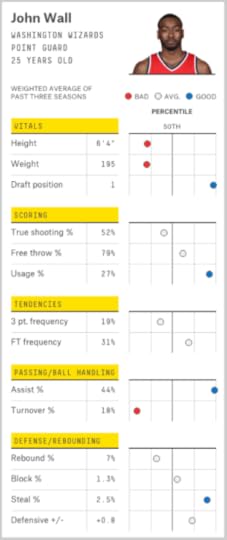
It starts with some basic biographical information for each player. The most important attribute of all, in terms of determining a player’s future career trajectory, is his age. NBA players, like MLB players, improve on average through about age 27 and then begin to decline after that. The age listed on a player’s CARMELO card reflects his age as of Feb. 1, 2016, the rough midpoint of the upcoming NBA season.
Next, we list a player’s vitals: his height, weight and draft position. It’s almost always better for a player to be taller and bigger, other things held equal. Players chosen with an earlier draft pick tend to have a higher ceiling, meanwhile, even once we control for other variables.3
Below a player’s vitals, you’ll see a number of statistics listed. Note that these categories are not projected statistics; instead, they reflect the weighted average of a player’s performance over his past three NBA seasons, with the most recent season weighted more heavily.4
We start with a few statistics related to his scoring and shooting ability. (For more precise definitions of these, see Basketball-Reference.com’s glossary page.) Usage rate reflects what percentage of a team’s possessions were “used” by a player in the form of a shot, turnover or trip to the free-throw line. Because there are five NBA players in a team’s lineup at one time, the average usage rate is 20 percent.
True shooting percentage is an “enhanced” version of shooting percentage that reflects the value of 3-pointers and made free throws, in addition to 2-point shots. Players like LeBron James and James Harden, who rank highly in both usage rate and true shooting percentage, are the best scorers in the game, providing both volume and efficiency. We also list a player’s free-throw percentage. Although less important to his overall value, it provides a purer gauge of shooting ability than true shooting percentage, which reflects both shooting ability and shot selection. In fact, it’s best to look at these categories in tandem with one another. The Clippers’ DeAndre Jordan has one of the best true shooting percentages in the league despite being an incompetent free-throw shooter because most of his shots are high-percentage dunks and layups near the rim.
The next two categories, 3-point frequency and free-throw frequency, reflect what shots a player is taking rather than how often he’s making them. (Three-point frequency is the percentage of a player’s field goal attempts that are 3-pointers; free-throw frequency is his ratio of free-throw attempts to field-goal attempts.) It’s usually desirable to rank highly in both departments. Free throws — unless you’re DeAndre Jordan — are generally the most efficient shots in the NBA and are a reward for a player’s ability to work effectively in the paint. Three-pointers, meanwhile, remain more efficient than 2-pointers, on average. Furthermore, ranking highly in one or (especially) both categories can reflect a player’s ability to stretch the court and provide for better floor spacing, which may have a favorable effect on his teammates.
Next are two familiar attributes related to a player’s ball-handling: his assist rate (what percentage of his teammates’ field goals are assisted by him, while he’s on the court) and turnover rate (the share of team possessions that result in a turnover by the player). For CARMELO purposes, a high turnover rate is considered bad, just as it is in the NBA. Wall’s high turnover rate is one of the few major negatives with his game, for example.
Finally are a set of categories related to a player’s rebounding and defense. His rebound rate is the share of rebounds he grabs while on the floor (10 percent is average). His block rate is the share of opponents’ 2-point field-goal attempts that result in his blocking a shot, and his steal rate is the share of opponents’ possessions that end in his stealing the ball. Last is a player’s defensive plus-minus rating. CARMELO’s plus-minus ratings reflect a 50-50 blend of Box Plus/Minus (BPM) and Real Plus-Minus (RPM). I’ll have more to say about plus-minus ratings in the “Fine Print” section down below; the important thing to know for now is that a rating of zero reflects an average defender, rather than a poor one.
Step 2. Identify comparable playersThese statistics can sometimes tell a reasonably complete story about each player. In Wall’s case, they describe a high-volume, medium-efficiency scorer who distributes the ball really well. He’s also a good athlete who plays good defense, especially for a point guard. On the downside, Wall commits a lot of turnovers. And he neither shoots all that many threes nor draws all that many fouls, which can make his game flat at times.
These categories, along with a few others related to durability and playing time, form the basis for selecting CARMELO comparables. The basic idea is this: Because Wall is 25 years old this season, CARMELO runs a profile for past NBA players5 heading into their age-25 season.6 Then it identifies the most similar ones. Historical players start with a perfect similarity score of 100, and points are subtracted for every difference. Because Wall has a high assist rate, for example, a player with a low assist rate will lose a lot of points and is unlikely to be among Wall’s top comparables. CARMELO applies this process for 19 statistical categories, some of which are weighted more heavily than others.7
The process sounds complicated, but the comparisons are sometimes intuitively satisfying. As a Pistons fan growing up, for example, I can see the similarities between Wall and his No. 1 historical comp, Isiah Thomas. Compare their stats on Basketball-Reference.com and you’ll see where CARMELO is coming from: They are eerily alike in some respects. Even so, the comparison is not perfect. Thomas drew more contact around the basket, resulting in more free-throw attempts. But he was undersized, whereas Wall isn’t, exactly.
Like snowflakes, in other words, no two NBA players are exactly alike. While a theoretically perfect similarity score is 100, Thomas registers at a 57 instead. By CARMELO standards, that’s high: Many NBA players don’t have any comparables with a similarity score above 50. And similarity scores above 60 are even rarer.
This is partly because of the way CARMELO defines similarity scores. A score of 0 is average, not bad. Dominique Wilkins has a similarity score of about 0 relative to Wall, for instance; they’re not much alike, but they aren’t totally off one another’s radar. Many players will have negative similarity scores instead; Manute Bol’s similarity score to Wall is -113.8 Here’s a rough guide for interpreting similarity scores:
SIMILARITY SCOREDESCRIPTION100Perfect score; identical60-99Separated at birth50-59Extremely similar40-49Highly similar30-39Mostly similar20-29Partly similar1-19Somewhat similar0As similar as dissimilarMore dissimilar than similar
You can find a more technical description of CARMELO similarity scores, which are calculated using a version of a nearest neighbor algorithm, in the footnotes.9
Step 3. Make a projectionEach player’s top 10 comparables are listed in his CARMELO card. Each comp has a mini-graph (sparkline) depicting how that player’s career progressed over the next seven seasons, where applicable,10 based on wins above replacement (WAR):

So a player’s CARMELO projection is formed just by averaging the career tracks for his top 10 comparables? That’s pointing in the right direction … but doesn’t quite tell the whole story.
For one thing, though only the top 10 comparables are listed on a player’s CARMELO card, the system uses all historical players with a positive similarity score to make its forecasts.11 Usually this means that dozens and oftentimes hundreds of players are used in generating a forecast; 179 historical players have a positive similarity score to Wall, for instance. Each player’s contribution to the forecast is weighted by his similarity score: A player with a similarity score of 50 will have twice as much influence on the forecast as one with a score of 25, for example.
The second issue is more technical. Take a look at Stephen Curry’s CARMELO card, for instance.
Although Curry has a few extremely flattering comparables — Michael Jordan! — most of the others are not as good as him. Terrell Brandon, Terry Porter and Chris Mullin, for example, are listed among Curry’s top 10 comps. They were good players, perhaps slightly underrated players, but none achieved the heights of excellence that Curry has already realized. They were a poor man’s version of Steph Curry — in mostly the same style as Curry, but inferior across the board. CARMELO is aware of this problem and has a solution to it called a baseline projection, which I describe in the footnotes.12
Think probabilisticallyA more important theme is that CARMELO’s forecasts are probabilistic. Wall is projected to finish with 8.7 WAR next season, for example. But there’s uncertainty around that estimate. Each player’s chart shows a range spanning the middle 80 percent of likely outcomes for the player.

These forecast ranges are often quite wide. Basketball is possibly the most predictable of the four major U.S. professional sports, but it still contains a lot of uncertainty. Wall’s range spans from 4.7 wins above replacement (not much better than a league-average player) to 12.9 wins (a possible All-NBA candidate), for example. And to reiterate, this range covers only 80 percent of his outcomes. If CARMELO is well-calibrated, then Wall has a 10 percent chance of exceeding the high end of his range (in which case he could be an MVP candidate) and a 10 percent chance of falling below the low end of his range (in which case, he’ll extend D.C.’s sports misery). Some players have wider ranges than others, especially young players such as Andrew Wiggins or players coming off injury such as Paul George.
The fine printSo far, we’ve mostly been discussing a player’s wins above replacement projection. But WAR is the endpoint in a CARMELO forecast and not the starting point. If you scroll down to the bottom of each player’s CARMELO card, you’ll see a section called “The Fine Print,” which provides further insight into how the WAR sausage is made.
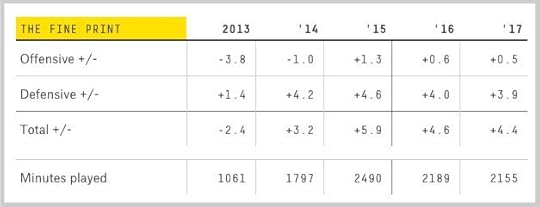
In particular, WAR reflects a combination of a player’s projected playing time and his projected productivity while on the court.13 Productivity is measured by the statistic plus-minus, which requires some explaining.
Mathematically, plus-minus is not that hard to define: It reflects how many points a player contributes to his team’s scoring margin per 100 possessions, relative to an average player.14 Wall, for instance, had a plus-minus rating of +3.9 for the Wizards last year. That means with Wall on the court, along with four average players, the Wizards were outscoring their opponents by 3.9 points per 100 possessions. Plus-minus can be broken down into offensive and defensive components. Wall had an offensive plus-minus of +2.5 last season, which is how many points he added to the Wizards’ scoring per 100 possessions. And he had a defensive plus-minus of +1.4, which is how many points he subtracted from his opponents’ scoring with his defense.15
However, there are many versions of plus-minus, ranging from simple to complex. The version we use for CARMELO reflects a 50-50 blend of Daniel Myers’s Box Plus/Minus (BPM), a relatively simple statistic that can be calculated by using conventional “box score” statistics, and Jeremias Engelmann’s Real Plus-Minus (RPM), a more complex statistic derived from play-by-play data.16
Neil Paine, our senior sports writer, and I had a lot of debates (which echoed long-running arguments within the broader basketball stat-geek community) about which advanced statistics to use for CARMELO before deciding on this BPM/RPM blend. What settled the debate was that the BPM/RPM blend did better than alternatives like PER and Win Shares in a variety of out-of-sample testing.
However, no all-in-one advanced stat is magic, and this is a source of systematic uncertainty in any NBA projection system. If it seems as though CARMELO “loves” or “hates” a certain player, it may be because of how BPM and RPM rate the player. For instance, both BPM and RPM rate the Raptors’ Jonas Valanciunas poorly compared with statistics like PER. So if Valanciunas’s forecast seems pessimistic to you, it’s not because CARMELO expects his performance to decline (in fact, CARMELO has him getting a little better). It’s because BPM and RPM didn’t evaluate Valanciunas as being all that good to begin with.
CARMELO also projects each player’s minutes in upcoming seasons. These forecasts may seem pessimistic. Among the 29 players who played at least 2,500 minutes last year, for example, CARMELO forecasts 26 to play fewer minutes this year. But this reflects the reality of NBA history. Even players who had been entirely healthy up to a certain point in their careers, such as the Pacers’ Paul George, have sometimes suffered catastrophic injuries. Or they underwent some other life circumstance ranging from illness to suspension to an unexpected retirement. In fact, CARMELO’s playing time projections are designed to be slightly optimistic, on average.17
Which players are included in CARMELO?Whew. We’ve gotten through WAR wars. Now for a few odds and ends. For instance, are you curious about a certain player but don’t see a CARMELO card for him? Or are you wondering why you are seeing a CARMELO card for a player who’s retired or hurt?
Our interactive includes every player who played at least 100 NBA minutes in the 2014-15 season, or 250 minutes in 2013-14. This includes players such as Shane Battier who we know are retired; we figure there’s no harm in showing their projections in case they decide to return to action this season.
We’re also showing projections for players who we know have suffered a serious, season-threatening injury, such as the Hornets’ Michael Kidd-Gilchrist. The reason for this is transparency; we think it’s cheating to omit a player based on news we’ve subsequently learned about him when that knowledge wasn’t available to CARMELO. However, we do account for injuries when formulating team depth charts, a process I’ll describe in a moment.
Rookie projectionsWe’ve also run projections for about 80 rookies with college experience; here’s D’Angelo Russell’s sweet-looking projection, for instance. These projections are derived from a database provided to us by ESPN Stats & Info, which includes strength-of-schedule-adjusted college statistics for prospects in the 2001 NBA draft class onward who subsequently played at least one NBA game.
Technically, these rookie projections are produced by a different program from CARMELO, one we sometimes call FABMELO after the Syracuse star (and seeming NBA flop) Fab Melo. However, the principles behind rookie and veteran projections are the same, and the differences boil down to a few relatively minor details:
Rookie projections omit a couple of statistics18 that were not included in the Stats & Info database. They also use Effective Field Goal Percentage (eFG%) in place of true shooting percentage.The weights assigned to identify comparable players are somewhat different. Draft position is weighted much more heavily in college projections, for example.Whereas veteran projections treat age as an absolute — a 31-year-old will be compared against only other 31-year-olds — rookie projections are slightly more flexible. A 21-year-old draft pick might be compared against a 20-year-old draft pick if they’re otherwise extremely similar, for instance.Whereas for veterans, CARMELO formulates a baseline projection based on a player’s age and playing time and plus-minus rating in his past three NBA seasons, rookie projections use a player’s age, draft position and height.19The tl;dr version: Rookie projections rely heavily on a player’s age and draft position. A No. 1 overall pick is almost always going to get a reasonably favorable projection, while a late second-round pick almost always won’t. Still, now and then the system will find a player it really likes (such as Russell) or dislikes (such as Frank Kaminsky) relative to his draft position; we’ll see in a few years how those forecasts turn out.
Finally, there are a few oddball cases. We’ve run rookie projections for a couple of players such as Josh Huestis who were chosen in the 2014 NBA draft but received little or no NBA playing time last year. This includes the Lakers’ Julius Randle, who played in just one game last year before getting hurt. CARMELO is fairly punitive toward players with a “gap year” between their draft year and their first prolonged NBA action, however.
What about draft picks from Europe (or other continents) who didn’t play U.S. college ball? They don’t get full-fledged CARMELO projections. (Sorry, Kristaps Porzingis.) However, we do run simple, baseline projections for them based on their age, height and draft position, so you may see them included in team depth charts.
Team projections and depth chartsIn addition to running player forecasts, we’re also releasing team-by-team projections that include projected win-loss totals for each club.20 Here are the Oklahoma City Thunder, for example.
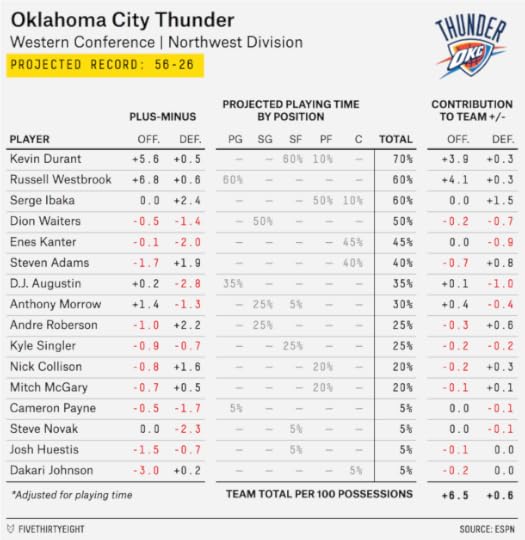
Unlike the player forecasts, these team projections involve some human intervention. In consultation with ESPN’s NBA beat writers, we’ve developed a depth chart for each team, which accounts for current injury information along with other news about a team’s roster construction. However, we aren’t taking too many liberties. If the playing time we assign to a player significantly exceeds the playing time recommended by CARMELO, the system responds by lowering his plus-minus rating; Manu Ginobili would not be very effective if asked to play 36 minutes a game, for example. This has the effect of rewarding deep teams (like Ginobili’s San Antonio Spurs) and punishing those that are stretching to fill out the roster.
So … should I bet on these things?Hmm. Umm. Probably not? FiveThirtyEight’s relatively simple, RPM-based projections performed quite well last year, edging out Vegas along with most other projection systems. In theory, based on our back-testing, CARMELO should be slightly more accurate still, improving on the simple RPM projections by about 10 percent. But back-testing is not the same thing as seeing how predictions perform in the real world against truly unknown data. Rookie forecasting models can be buggy, moreover. I’d probably hold off until the system has at least a year or two of experience under its belt.
Does Carmelo Anthony get a good CARMELO projection?No, not really. In fact, CARMELO sort of hates the Knicks; it doesn’t play favorites.

October 7, 2015
Should Jeb Bush Be Freaking Out Right Now?
It’s time again for our weekly 2016 election Slack chat, in which FiveThirtyEight’s political team debates the latest developments. As always, the transcript below has been lightly edited.
micah (Micah Cohen, politics editor): So, is Jeb! toast? There’s been a spate of articles recently suggesting he should be panicking right now. And he’s at a low ebb in national polls:
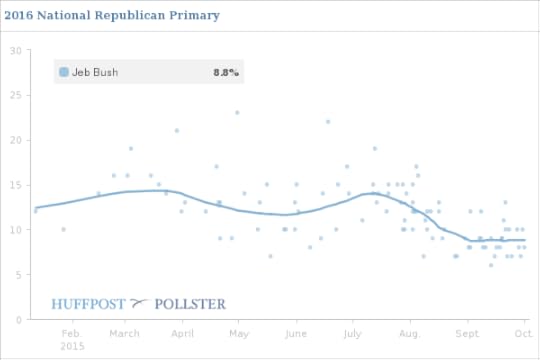
hjenten (Harry Enten, senior political writer): Why should he panic? The leader in the polls is Donald Trump (though trends indicate that he may not be for much longer). A man who basically spent no money on his campaign. A man whose favorable ratings are dropping. Second is Ben Carson and third is Carly Fiorina — neither have ever held elected office. Bush has the most money, the most endorsements … so NO, I wouldn’t panic.
micah: I mean, he’s leading in endorsements, but only a small share of GOP bigwigs have endorsed anyone — those don’t mean much yet, right?
natesilver (Nate Silver, editor in chief): Bush shouldn’t panic, but he should worry. Most of those endorsements came early in the race. He hasn’t received any in the past couple weeks, whereas Marco Rubio has received three. That’s not that many — but at the very least we can say the establishment is not rallying around Bush.
hjenten: Yes, I think it would be fair to say that Bush isn’t winning. I’m not sure it is fair to say that he is losing.
micah: He’s … existing.
natesilver: Gut-check: What are Bush’s chances of winning the nomination?
hjenten: 25 percent.
natesilver: OK, I’m about in the same ballpark as you, Harry. Predictwise has him slightly higher, at 30 percent.
hjenten: Yes, but note: Our 25 percent for Bush is down a little — despite Walker leaving the race.
natesilver: I’d put Rubio ahead of Bush instead of the other way around.
micah: Harry, would you put Rubio above Jeb too?
hjenten: I’d put them even. Look, Rubio is hot right now, but let’s see where he is in a month or two.
micah: So why would you put Rubio ahead, Nate?
natesilver: For one thing, I think he’s a better fit for the party ideologically. Maybe not perfect, but he’s pretty close to being “just right” in terms of being pretty damn conservative without being “extremely” conservative. Whereas Bush is genuinely moderate, in some respects.
For another, Rubio gives Republicans a fresher look and is less blatantly part of the same old, tired establishment. I think the “Republicans are in the mood for an outsider!” meme is slightly overstated for various reasons. Most notably that those insider/outsider numbers seem to have moved as a result of Trump and Carson’s surge, rather than preceding it.
But still.
It’s a long way to go from Trump/Carson/Fiorina and wind up all the way at Bush, who is about the most unapologetically, capital-e Establishment candidate of all time. Rubio has less distance to bridge.
hjenten: The question with Rubio is, can he take it when the spotlight is on him? Remember, he came out smoking after he won his Senate seat in 2010, then the immigration thing happened, he got a ton of media attention and fell back. Where will he be after the press attention comes upon him this time?
Also, Bush is just starting to use that war chest. He’s got lots of money. That’s not an awful position to be in.
natesilver: Yeah, Rubio hasn’t really been through a cycle of intense scrutiny yet. And he’s due for one soon.
micah: So we began this chat talking about Jeb’s chances and quickly moved to Rubio’s chances — why?
hjenten: Because they are the two most plausible candidates at the moment IMHO.
natesilver: Yeah, especially with Walker out of the race, there aren’t all that many plausible “party decides” choices. It’s just Bush, Rubio and probably Kasich.
micah: So you’re expecting whoever wins among those three to be the nominee?
hjenten: There are other candidates who can win, but I think in most universes, it’s one of those.
natesilver: I’d say team BRK (Bush-Rubio-Kasich) collectively have a 70-75 percent chance or so. Divide the remaining 25 percent between some long-shot establishment-ish options (Bobby Jindal?!? Chris Christie?!?!? Romney?!?!?!?!?) and an insurgent winning.
hjenten: Don’t dismiss Ted Cruz; I’d give him a 5 percent chance or so right now. But otherwise, yes, I agree.
micah: Maybe in the abstract Jeb shouldn’t panic right now, but couldn’t even premature panic become a self-fulfilling prophecy? The Washington Post reported that Bush donors are giving the campaign a month to show some signs of life in the polls “or face serious defections among supporters.”
natesilver: Yeah, that was an interesting story. And there are reasons to believe it and disbelieve it.
In the disbelief camp: It seems like money is unlikely to be the foremost problem for Bush. And the story was based almost entirely on anonymous sourcing.
In the belief camp: It’s a Washington Post story and, IMO, the Post has a better ratio of actual reporting to unfounded gossip/narrative-setting crap than a lot of outlets. Also, there’s some confirmation of that Post story in Bush’s lack of endorsements lately, and his sluggishness in the polls.
hjenten: Okay, here’s the thing: Bush is now advertising on TV heavily in Iowa and New Hampshire. If his numbers aren’t moving after a month, then why would they move in three months? After a while, you reach a saturation point. So the story doesn’t seem ridiculous to me.
micah: But Harry, maybe Jeb won’t see much growth in a month, while other candidates in his “lane” are still pulling support (i.e. Rubio, Kasich, etc.), but who’s to say Rubio won’t flame out in a few weeks? Same with Kasich?
hjenten: That’s a rather interesting point, Micah. I think that’s part of the reason using a wait-and-see approach isn’t the worst idea at this point. It’s October.
micah: Right, maybe we should call Jeb’s donors and tell them to calm down.
natesilver: Let me flip the script a bit. Why should Republicans choose Bush? He’s not particularly conservative. But usually the more moderate candidates are at least more electable, and it’s less clear that’s true for Bush.
His favorability ratings with the general electorate remain pretty poor. Yes, it’s early, and that can and will change — but he doesn’t have the sort of head-to-head numbers against Clinton or Biden that would allow him to brag to donors.
And if there’s any tinge of anti-establishment sentiment in the electorate, that could outweigh whatever advantage Bush has by being slightly closer to the center than Rubio.
hjenten: You’re assuming a number of things, though: First, that general election polls right now mean something. There were points in the 2012 cycle when Romney polled weaker against Obama than Rick Santorum. I doubt most would say Santorum was ever more electable than Romney.
natesilver: But Bush’s numbers have been middling for a long time, despite high name recognition.
hjenten: Second, that Bush is polling all that poorly against Clinton. He seems to be doing better than most of the other GOP candidates.
natesilver: He’s doing worse than Carson!
hjenten: And better than the rest!
And three, can most people pick out Jeb vs. George?
micah: Yeah, I wonder how much in these early polls respondents see “Bush” and think “George.”
natesilver: That’s possible, although George W. Bush’s favorables aren’t so terrible right now. A little bit of a post-presidency halo.
Look, I emphatically agree that the general election numbers aren’t very meaningful right now. I give slightly more weight to Bush’s numbers because they’ve been mediocre for a long time, instead of as the result of a rough patch of negative news coverage, etc. But I wouldn’t put all that much emphasis on it.
Still, Rubio can claim that he provides a better contrast to Clinton. He can claim that he’ll help Republicans with Hispanics. (Which is a claim we probably ought to scrutinize at some point, but it’s not a ridiculous argument.) And he’s almost certainly more conservative. If electability is a draw, Rubio wins, no?
Podcast: Harry Enten, Micah Cohen and Nate Silver talk election 2016http://c.espnradio.com/s:5L8r1/audio/2560380/whatsthepoint_2015-10-06-113320.64k.mp3?ad_params=zones%3DPreroll%2CPreroll2%2CMidroll%2CMidroll2%2CMidroll3%2CMidroll4%2CMidroll5%2CMidroll6%2CPostroll%2CPostroll2%7Cstation_id%3D3138Recorded as part of Advertising Week 2015. Download in iTunes. Find all the FiveThirtyEight podcasts here.
hjenten: I think you’re talking about two things here: 1. Should Bush panic? 2. Is Rubio better than Bush?
micah: Doesn’t the answer to #2 inform the answer to #1?
natesilver: Here’s what I’m saying: Bush isn’t winning now, as we’ve agreed.
So the notion that he’ll win eventually is based on some sort of reversion to the fundamentals. But I think the “fundamentals” — what we’ve learned from patterns in past campaigns — are more favorable to Rubio than Bush.
micah: But it’s not necessarily true that Bush winning requires a reversion to the fundamentals. As we’ve said, Rubio hasn’t been in this kind of spotlight before — he could blow it, even if he’s a better fit on paper for the GOP (see Walker, Scott).
natesilver: Sure. Which is why I still give Bush a 25 percent chance. If a) This Time Isn’t So Different After All and b) Rubio isn’t ready for prime time or peaks too soon, then Bush has a pretty good chance. It’s a plausible story.
However, what stories like the Post’s tell us, along with the sluggishness in endorsements, is that he’s not necessarily the GOP’s default choice any more. It seemed like there was a chance this spring that he might win the campaign on the basis of inertia alone, and that seems less likely now.
hjenten: I don’t think he was ever the “default” choice. I’m not sure why people thought that. When he didn’t get a ton of endorsements out of the gate, it was fairly clear (to me anyway) that he wasn’t the default choice. Indeed, if you go back and look at the articles we wrote in the spring, you see that. We were always high on Rubio.
So to me, what we’ve seen so far from Bush and Rubio isn’t surprising at all.
The questions that remain unanswered are:
Can Rubio withstand the spotlight?Is Rubio too conservative to win the nomination? (By our three-pronged metric he would be more conservative than any Republican nominee since Barry Goldwater.)How much of an advantage does Bush’s money give him?And, lastly, does Bush begin to look more attractive to party officials as people tune in?IDK the answers to these questions.

Nate Silver's Blog
- Nate Silver's profile
- 729 followers





